The Surveying and Research Lab is a comprehensive, well-equipped facility designed to provide students with practical experience in applying the principles taught in theoretical surveying courses. The lab is stocked with nearly all the essential surveying equipment necessary to support a range of activities in civil engineering, building engineering, architectural engineering, urban planning, and geography. It is designed to foster an environment where students can seamlessly integrate theoretical knowledge with hands-on practice.
Equipped with advanced scientific instruments and high-tech computing resources, these labs enable cross-disciplinary experimentation in engineering, life sciences, data science, and emerging technologies, enhancing collaboration and discovery.
Interdisciplinary Research Labs :
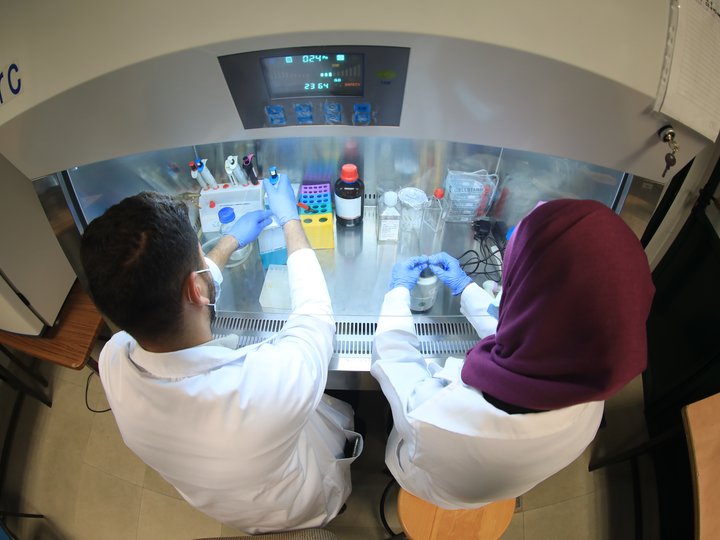
The recent progresses on the research field of biomedical sciences and its different areas necessitates providing the infrastructure and services needed to keep pace with the advances in the different scientific disciplines. To achieve that, An-Najah National University offers its medical students at the Faculty of Medicine and Health Sciences the central research laboratory, which is well-prepared and equipped with the latest tools and devices needed for the scientific research.
The central research laboratory consists of:
Genetic Research and Cell Transplant Lab : It aims to carry out research regarding genetics, molecular biochemistry, and cell transplant in terms of:
- Discovering genetic mutations and their relation to genetic diseases.
- Molecular Medicine Science, which studies infectious and chronic diseases at the molecular level.
- Studying the impact of medicines, plants, and organic compounds on the different cells and tissues through a special discrete unit.
- Studying cellular signs and means of regulating them in normal cases as well as diseases.
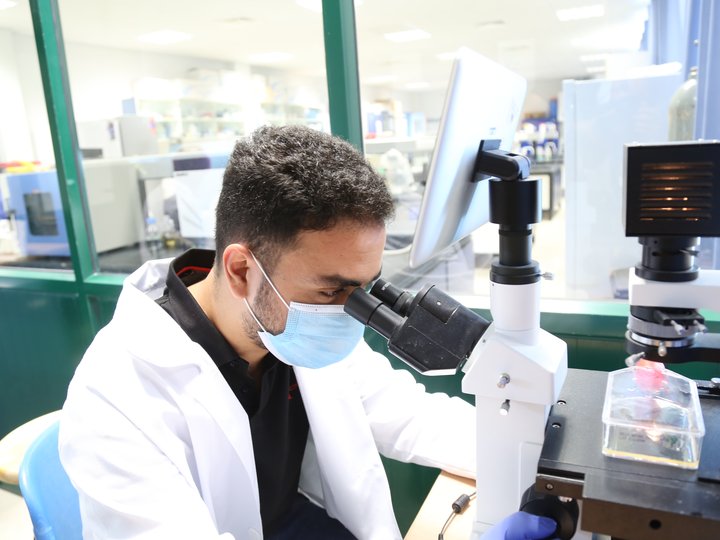
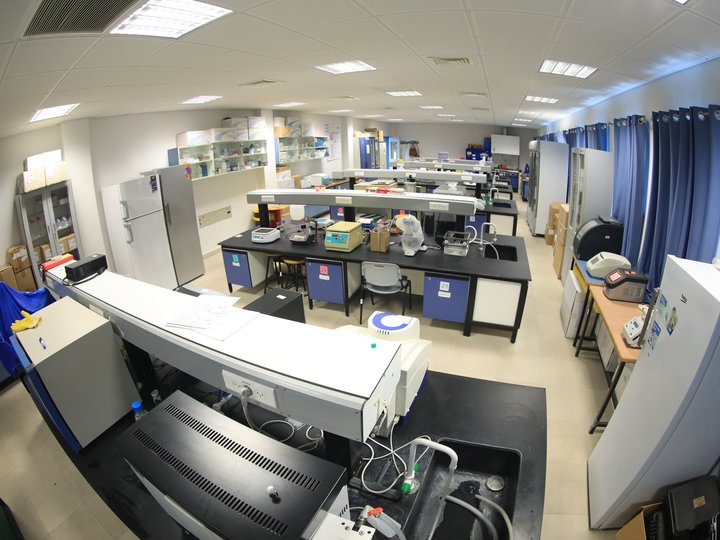

The Neuroscience Research Centers on Glutamate Ion Channel Receptors (iGluRs). These receptors mediate synaptic neurotransmission and are indispensable in brain activity, such as memory and learning. Upon binding to glutamate, the glutamate receptor rapidly changes its conformation and opens its ion channel pore to allow small cations such as sodium ions to flow across the cellular membrane, transmitting an electrical signal between neurons. Moreover, research will concern the membrane proteins on the cell surface. The activity of virtually every cell is regulated by extracellular signals, such as neurotransmitters, hormones, and sensory stimuli. These signals are transmitted into the cell interior via membrane receptor proteins. Understanding how these membrane proteins mediate signal transmission and transduction is the primary research interest in the neuroscience laboratory. We are particularly interested in the structure and function relationship, the kinetic and molecular mechanism of protein function by protein-protein and protein-drug interactions. We also attempt to develop better inhibitor/potentiators to regulate membrane protein functions. In the long term, we hope that our research will provide not only insight into the mechanisms of action of these molecular machines but also clues for the design of molecular devices, which can be used (i) for studying signal transduction pathways and (ii) as diagnostic/detection tools for disease treatment. We use an interdisciplinary approach in our research, including rapid kinetic techniques suitable for membrane proteins, biochemical and biophysical chemistry, molecular biology, electrophysiology, and neuroscience.
Neuroscience Center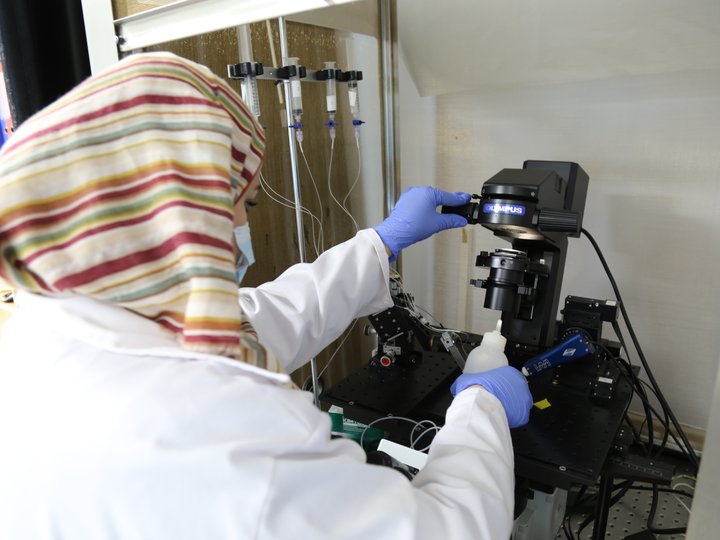

Conducts basic, translational, and clinical research to develop novel drugs to assist the body in killing cancer cells and develop optimal conditions to regrow, repair or replace damaged or diseased cells, organs or tissues.
The aim is to translate findings into clinical trials that make a difference in the lives of patients (from bench to bedside) as we work in tandem with academic and industry colleagues.
The goals are to identify critical genes and pathways that distinguish cancer from normal (stem) cells, isolate tissue-specific stem cells and define the conditions that are required to repair damaged tissues, develop novel drugs for cancer therapy and regenerative medicine, fix defective, disease-causing genes (gene therapy) and re-growth of damaged tissues (body parts).
An-Najah Center for Cancer and Stem Cell Research
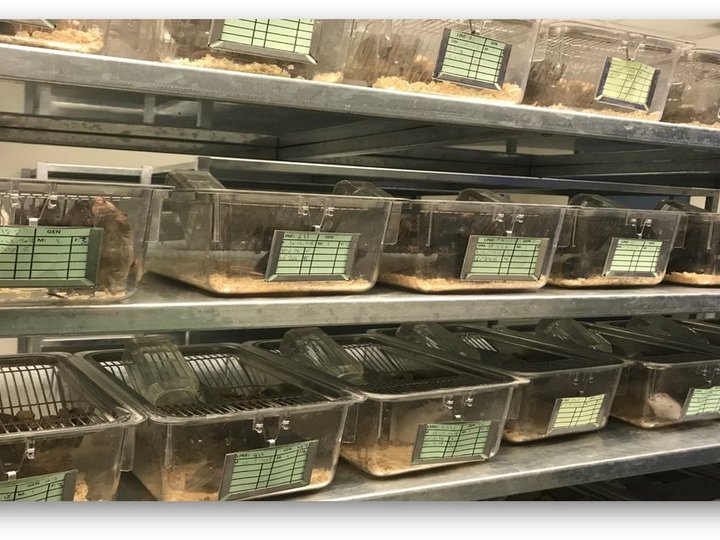
The animal lab is a service unit. It was established in 2016 with the primary mission to breed specific laboratory animals free of pathogens for research and education purposes, mainly for the faculty of medicine and health sciences, although animals are also provided for other departments and units of the university. The lab also provides advice on matters related to laboratory animal science.
The lab is divided into :
- Stock room, which includes mice (Balb/c & C57) and hamsters, where reproduction is made upon request.
- Research room, where the mice are separated according to protocols and scientific research.
In the Medicinal Plant Products Research Laboratory, various types of medicinal plants are studied in terms of:
- Preparing several types of plant extracts and extracting essential and fixed oils, if any, with the latest equipment.
- Conducting a set of laboratory tests to find out the active substances in each prepared plant extract.
- Examination of essential oils using gas chromatography device.
- Conducting tests to detect the safety of the plant and its readiness for human use.
- Measuring the effectiveness of plant extracts as antioxidants and their ability to inhibit free radicals.
- Examination of the effect of plant extracts on lipase, amylase and skin enzymes.
- Studying the effect of plant extracts and different essential oils as antimicrobial on different types of microbes (bacteria, fungi, etc.)
The pharmaceutical technology lab is concerned with the development of new pharmaceutical formulations to provide the adequate dosage form. The lab is equipped with the up-to-date required instruments such as ultrasonicators, thermogravimetric analyzers, differential scanning calorimeter, dissolution apparatus, tableting machine, extruders and granulators.
The lab deals with the basic and applied research for the innovation of various dosage forms to design, as required, drugs with specific characteristics such as controlled and sustained release properties.
This lab is considered a comprehensive center equipped with the latest tools and equipment that students may need in various practical fields. The lab is distinguished by providing an ideal environment for practical and experimental work, which enhances students' ability to apply the theoretical concepts they learn in the classroom.
The availability of advanced tools in the lab not only contributes to training students on how to use modern technologies in the field of computer engineering but also offers an excellent opportunity for scientific research. Students and researchers can conduct scientific experiments and practical studies that contribute to developing new solutions for contemporary technical challenges. Moreover, the lab helps enable students to carry out research that keeps up with rapid developments in fields such as artificial intelligence, the Internet of Things, and cybersecurity, thereby strengthening the university's role in developing knowledge and contributing to scientific progress at both local and international levels.
By integrating the lab with scientific research, students can participate in research projects, field experiments, and technological development programs that help enhance their abilities and motivate them toward creativity and innovation.
Tools and Equipment:
-
Power Supply: Used to provide the necessary power to electronic components and devices in practical experiments.
-
Function Generator: A device used to generate electrical signals in various waveform shapes (e.g., sine, square) to test electronic circuits.
-
Oscilloscope: A device for displaying and analyzing electrical signals, providing insights into how signals change over time.
-
Chip Programmer: Used to program electronic chips and microcontrollers before using them in projects and circuits.
-
Serial Cables: Used for communication between devices and computers to transfer data.
-
Agilent Logic Wave: A device for analyzing digital data signals in the system to measure and record logical events.
-
Graphical LCD: Used to display information and outputs generated by controlled devices.
-
Quick Start 16 PIC Board 750: A development board that contains a PIC microcontroller. It is an ideal platform for learning programming and testing circuits.
-
Embest EM-AT91SAM3U: A development platform based on a 32-bit ARM processor, used for applications that require powerful processors.
-
Embest EM-STM3210C: A development platform based on the STM32 processor, suitable for control applications in complex systems.
-
PIC 32 USB Starter Kit II: A development platform from PIC that contains a 32-bit processor, ideal for building and testing advanced embedded systems.
-
MIKROELEKTRONIKA LV24-33 V6: A development board from MikroElektronika with a 24-bit PIC processor, used in many precise design applications.
-
BeagleBoard-XM: An open-source development board based on an ARM processor, used in advanced applications such as image and video processing.
Role of the Lab in Scientific Research: These tools and equipment can be effectively integrated into scientific research through their applications in fields such as:
- Development and design of embedded systems.
- Study and analysis of digital systems.
- Creation of intelligent solutions using microcontrollers.
- Improving the performance of electronic devices through practical experiments.
- Conducting scientific research in areas such as artificial intelligence, signal processing, and the Internet of Things.
Research students can benefit from these tools to execute their research projects and develop innovative models that keep up with the latest technological developments in electronic and computer engineering.
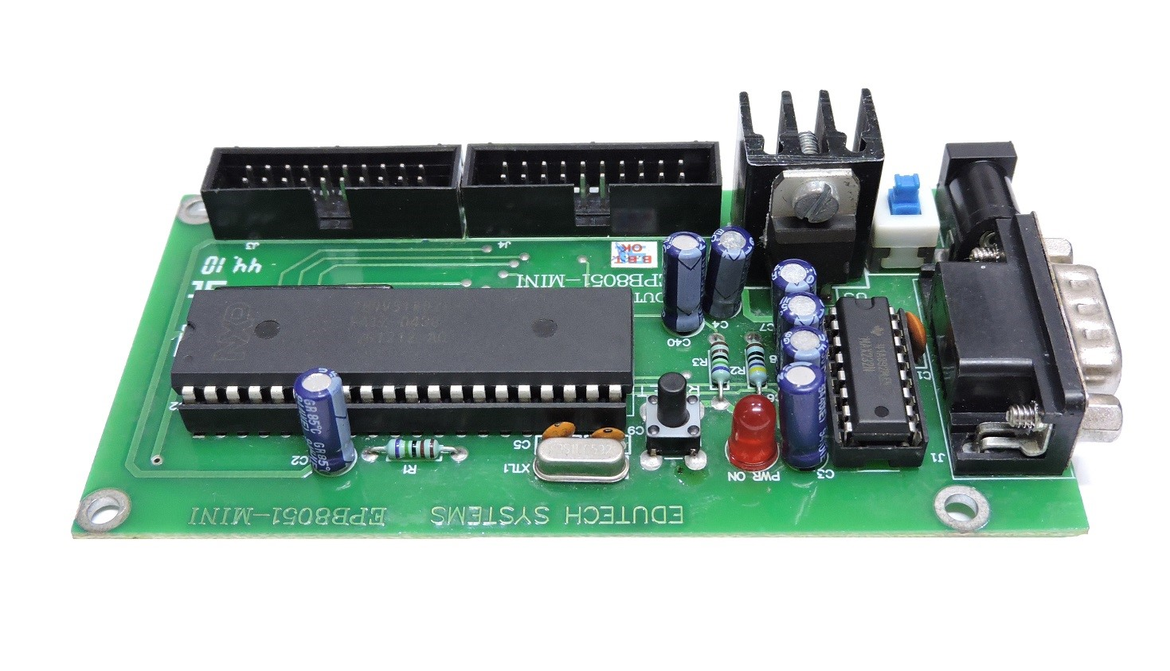
This lab is used to conduct scientific experiments related to networking and advanced networking courses, as well as network security research. The lab aims to provide an educational and practical environment that enables students and researchers to acquire the necessary skills in the field of networking and information security, by conducting experiments designed to understand network architecture, configuring devices, analyzing network protocols, and studying network defense and security techniques.
Scientific and Research Objectives:
- Study of Network Architecture: Examining how devices connect to each other using different cabling methods and configuring local area networks.
- Application of TCP/IP Protocols: Conducting experiments to understand how to configure workstations on the network and implement TCP/IP to enable communication between devices.
- Configuring Routers and Switches: Configuring basic routers and switches to route data between different networks.
- Creating Virtual LANs (VLANs): Learning how to divide the network into subnets to improve performance and management using VLANs.
- Data Traffic Management: Using Access Control Lists (ACLs) and SNMP to manage data traffic across the network.
- Security Analysis and Techniques: Conducting experiments on network security, including vulnerability analysis, penetration testing, and Intrusion Detection Systems (IDS).
- Encryption and Security Protocols: Studying encryption protocols such as SSL/TLS to ensure data protection during transmission.
- Incident Response and Forensic Analysis: Simulating security incidents and conducting forensic analysis to investigate attacks and improve security measures.
Equipment and Apparatus:
The lab is equipped with a variety of specialized equipment, including:
- Cisco Switch WS-C2950
- Cisco Router 2600, 2500, 1720
- Cisco Switch WS-C3550-48-SMI
- Super Stack 3com | 3C 16981 A
- Dual Speed Switch 8 port, 3Com 3C16791
- HUB 500 12 Port, 3Com DS
- Dell Server PowerEdge T410
- Remote Cable Tester (LAN tester)
- LAN test, Multi-Network Modular Cable Tester
- Case, Dell Optiplex P4, HP Compaq P4, Siemens HP P4
These devices are used to perform advanced network testing, check connections, and test network responses through various protocols. Security testing is conducted using tools such as Wireshark, Metasploit, as well as IDS/IPS tools like Snort and Suricata.
Importance of the Lab in Research :
This lab provides a research and experimental environment that helps students and researchers explore networking and security concepts practically. Through experiments that include security techniques such as firewalls and Intrusion Detection Systems (IDS), students can enhance their skills in developing effective security solutions. Additionally, research in the field of network security contributes to the development of new tools and techniques to protect networks from increasing threats.
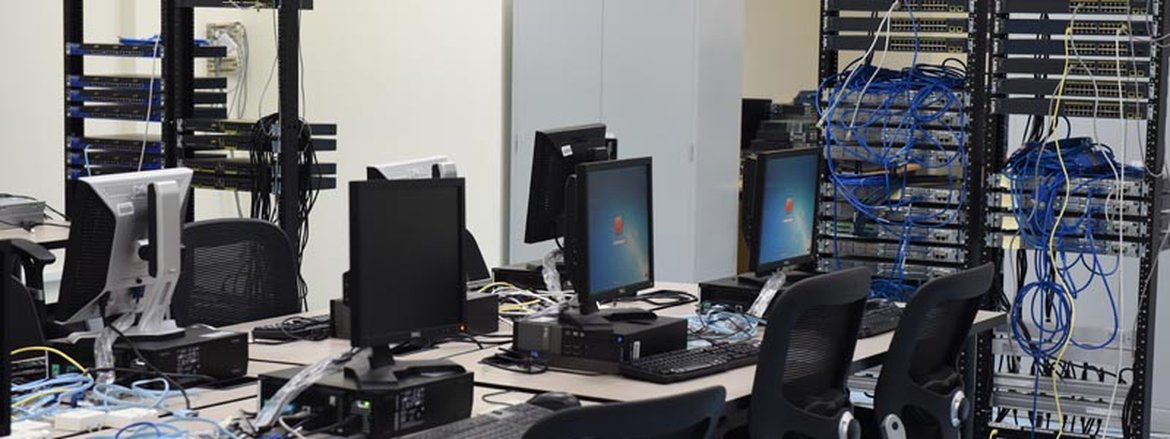
The Power Systems Research Lab is one of the leading and most advanced labs in the Department of Electrical Engineering. It integrates various interdisciplinary fields to provide a practical educational environment where students can conduct advanced tests on electrical power systems. The lab is equipped with modern, specialized devices that allow for the study and analysis of power systems, starting from generation units, through transmission lines, to load units with power factor correction panels.
Main Objectives of the Lab:
- Linking theoretical concepts with practical applications through advanced hands-on experiments on power systems.
- Providing students with real-world practical experience by working with actual power system devices and equipment.
- Performing comprehensive analysis of real power systems, from generation units to load units, considering all variables and interactions within the system.
- Encouraging interdisciplinary research between various engineering fields, such as electrical engineering, mechanical engineering, and civil engineering, by studying the interaction between different power systems and systems that rely on multi-disciplinary technologies.
Interdisciplinary research in this lab is not limited to improving students' understanding of basic concepts in power systems; it extends to collaboration across multiple domains such as electrical analysis, automation, precise measurements, and mechanical systems. Through these interdisciplinary interactions, students develop skills to understand how these systems can be integrated more efficiently and safely.
List of Experiments:
- Introduction to Power Systems Lab.
- Motor-Generator Unit.
- Transmission Line at No Load.
- Protection Relays.
- Transmission Line Performance Under Different Load Conditions.
- Parallel Operation of Generators.
- Series-Parallel Operation of Power Transmission Lines Under Load.
- Parallel Connection of a Three-Phase Synchronous Generator with the Public Mains.
- Studying the Operation of a Power Transmission Line in the Event of a Ground Fault.
- Power Factor Correction Using a Synchronous Compensator.
- Power Factor Correction Using C-PF/EV Panel.
- Studying the Operation of Protection Relays, Including Distance Protection Relays.
- Overall Power System Operation.
Through this approach, the lab contributes to enhancing interdisciplinary research and expanding collaboration across various engineering disciplines to provide innovative and sustainable solutions in the field of electrical power systems.
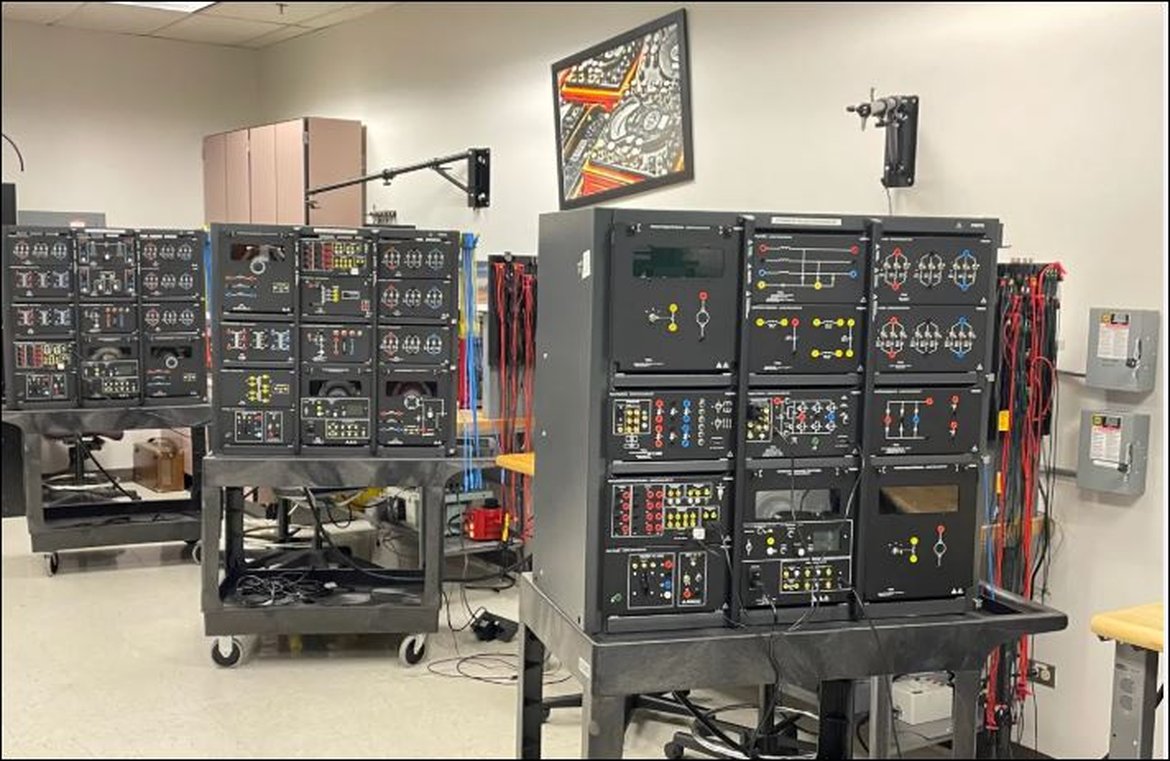
The Electrical Machines Systems Research Lab is an essential part of the electrical engineering curriculum, offering students an in-depth understanding of both DC and AC electrical machines, including motors, generators, and transformers. The lab is equipped with state-of-the-art devices and equipment, providing students with the practical tools necessary to conduct a variety of tests and measurements on single-phase and three-phase transformers, as well as DC and AC machines.
This lab not only serves to enhance theoretical knowledge but also fosters interdisciplinary research, integrating concepts from multiple fields such as electrical, mechanical, and control engineering. By working with these complex systems, students develop a holistic understanding of how electrical machines operate within broader power systems, gaining valuable hands-on experience while also improving their ability to collaborate across disciplines.
The Electrical Machines Systems Research Lab bridges the gap between multiple engineering disciplines, combining electrical, mechanical, and control systems engineering. Students explore the interaction between electrical machines and broader systems, such as how control systems influence the operation of motors or how mechanical properties affect generator efficiency. The integration of concepts from these diverse fields enhances students' problem-solving abilities and fosters interdisciplinary research in fields such as automation, energy efficiency, and advanced control systems.
The lab’s interdisciplinary approach is crucial for advancing technological innovations in the field of electrical machines. Students gain insights not only into the functionality of these systems but also into how they can optimize performance and solve real-world engineering problems that require knowledge and skills across multiple domains.

The Advanced Manufacturing Processes Research Lab aims to provide electrical, mechanical, and manufacturing engineering students with hands-on training, enabling them to gain real-life experience in some of the most important manufacturing processes used in industry today. The lab is equipped with a variety of machinery and tools to simulate industrial processes, allowing students to explore, experiment, and develop practical skills. The lab’s core focus is to bridge the gap between theoretical knowledge and real-world applications, helping students understand the manufacturing techniques that shape the products they encounter daily.
The lab covers essential manufacturing processes, such as conventional turning, milling, sheet metal working, and sand casting, and offers students the opportunity to familiarize themselves with Computer Numerical Control (CNC) programming and CAD/CAM systems. This enables them to understand how these processes fit into the broader landscape of automated manufacturing, robotics, and modern industry practices. Students also gain exposure to the fundamental concepts and tools used in designing and producing parts in the manufacturing industry.
Additionally, this lab emphasizes interdisciplinary research, where students explore the intersection of manufacturing processes with various fields such as electrical engineering, mechanical engineering, automation, and industrial design. Through a combination of hands-on experience and theory, students collaborate on interdisciplinary projects that enhance their problem-solving and critical thinking skills, preparing them for the future demands of the industry.
Main Objectives:
- To provide students with real-world experience in essential manufacturing processes, including conventional turning, milling, sheet metal working, and sand casting.
- To introduce students to CNC programming and CAD/CAM technology, enabling them to develop practical skills that align with current industry standards.
- To enhance students' understanding of the application of computer-aided design and computer-aided manufacturing in the production of industrial components.
- To encourage interdisciplinary research, fostering collaboration between different engineering disciplines to solve complex manufacturing challenges.
Apparatus:
- Lathe Machine: For turning operations, enabling students to shape and design cylindrical parts.
- Manual Cutting Threads Tools: For producing thread profiles on components.
- Milling Machine: A versatile machine used for cutting and shaping a variety of materials, critical in precision manufacturing.
- Deep Drawing Machine: For sheet metal forming and producing complex shapes.
- Metal Spinning Machine: Used for spinning metal sheets into cylindrical parts.
- Patterns, Gates, Risers, and Sprues Plates for Sand Casting: Tools and components necessary for the sand casting process.
- Centrifugal Casting Machine: A machine used to produce cylindrical castings by using centrifugal force.
- CNC Turning Machine: An automated machine for turning operations with the capability for precise control and programming.
- CNC Milling Machine: A machine for milling operations with computer-controlled precision.
In this lab, students also explore how electrical engineers’ knowledge of sensors and actuators can be applied to improve the efficiency of manufacturing systems. Additionally, mechanical engineers can collaborate with electrical engineers to design and prototype smarter and more efficient production lines, where real-time data collection and process optimization are central.
Through interdisciplinary research, students are encouraged to innovate and collaborate across fields, leading to solutions that are more comprehensive and aligned with the cutting-edge technologies and practices used in modern manufacturing environments.

The Materials Testing Research Lab is designed to provide undergraduate students with practical experience in applying the concepts and principles studied in the engineering material properties course. The lab is equipped with state-of-the-art apparatuses for testing and analyzing a wide range of material properties, helping students understand how materials behave under different conditions and how these properties are crucial in engineering applications. The focus of this lab is to bridge the gap between theoretical knowledge and real-world material testing, preparing students for the challenges they will face in the engineering industry.
This lab also emphasizes interdisciplinary research, where students explore the connections between materials science, mechanical engineering, structural engineering, and manufacturing processes. The knowledge gained from this lab provides a foundation for understanding how materials interact with different forces and environments, enabling students to innovate and apply this understanding in a variety of engineering disciplines, from design and manufacturing to energy systems and construction.
Main Objectives:
- To provide students with hands-on experience in performing standard material testing procedures, enabling them to understand material behavior under different loading conditions.
- To familiarize students with various tests such as tensile, torsion, impact, and hardness tests, which are essential for selecting materials for engineering applications.
- To give students an understanding of the effects of heat treatment, precipitation hardening, and other processes on material properties, which is critical for material selection in real-world applications.
- To encourage interdisciplinary research by exploring the relationship between material properties and various engineering fields, including mechanical engineering, chemical engineering, and civil engineering
Apparatus:
- Brook’s Pendulum Tester: Used for impact testing to determine the energy absorbed by materials during sudden force application.
- Universal Material Testing Machine: A versatile machine used for tensile, compression, and bending tests to measure material strength.
- Torsion Testing Machine: Used to measure the twisting resistance of materials, providing insights into shear properties.
- Grinding Machine: For preparing specimens by grinding surfaces to create smooth, flat finishes for further testing.
- Polishing Machine: Used for preparing material surfaces by polishing them to mirror-like finishes for metallographic examination.
- Microscope with Screen Support: Provides high magnification for examining material microstructures and identifying phases and defects.
- Vickers Hardness Tester: A machine that measures hardness by indenting a material with a diamond pyramid and evaluating the size of the indentation.
- Brinell Hardness Tester: Used for measuring the hardness of materials, particularly for materials with coarse or uneven grain structures.
- Furnace (Oven): For heat treatment processes like annealing, quenching, and tempering, altering material properties by controlled heating and cooling.
- Rubber Block: Used in the rubber shear test for evaluating the shear strength of rubber materials.
Through interdisciplinary research, students develop a deeper understanding of how the properties of materials influence various engineering challenges, and they apply this knowledge to create innovative solutions that are practical, sustainable, and efficient in real-world scenarios.

The Chemical Reactors Research Lab is one of the most essential labs in the chemical engineering curriculum. It offers students a comprehensive understanding of the fundamental concepts related to the operation of various types of chemical reactors, such as Batch Reactors, Continuous Stirred Tank Reactors (CSTR), and Plug Flow Reactors (PFR). This lab serves as an extension of the theoretical studies, providing hands-on experience to better understand reactor dynamics, conversion, mixing, and the factors influencing these processes.
In this lab, students perform experiments to measure the conversion in the three main types of reactors (Batch, CSTR, and PFR), exploring the relationships between reactor design, operating conditions, and efficiency. Students gain valuable insight into the impact of mixing in batch reactors, particularly by examining how impeller type, impeller speed, and impeller position influence conversion. These experiments are carried out with both viscous and non-viscous fluids, enabling students to observe how different materials behave under various mixing conditions. The mixing intensity is measured using a spectrophotometer, providing quantitative data to analyze the effects of mixing on the reaction rates.
Main Objectives:
- To provide students with practical experience in working with the most common chemical reactors (Batch, CSTR, and PFR).
- To study the effects of mixing on conversion and how different mixing strategies can improve reactor performance.
- To measure and analyze the impact of various factors such as impeller type, position, and speed on reactor conversion and efficiency.
- To enhance understanding of the relationship between reactor design, operating conditions, and the efficiency of chemical reactions.
- To encourage interdisciplinary research, where students integrate knowledge from various engineering fields to solve complex chemical engineering problems.
- Microprocessor-Based pH/mV/°C Bench Meters: To measure pH, potential, and temperature in the reactors, providing essential data for reaction monitoring.
- Chemical Reactors Trainer CE 310: A versatile apparatus for demonstrating the operation of various types of chemical reactors, allowing for hands-on experiments and measurements.
- LabTech LSB-Series Shaking Water Bath: For controlling the temperature and maintaining uniform heating in chemical processes that require consistent thermal conditions.
- Digital Over-Head Stirrer: Used for mixing fluids at different speeds to observe the effects of stirring on reaction rates and conversion in batch reactors.
- Molecular Spectroscopy: For measuring the intensity of reactions and analyzing the progress of chemical reactions in the reactors.
The Chemical Reactors Research Lab encourages interdisciplinary research by bringing together chemical engineering concepts with mechanical engineering principles, especially in reactor design, and process engineering. Students explore how reactors can be optimized for better mixing, energy efficiency, and reduced environmental impact.

The Heat Transfer Operations Research Lab is a key lab in the study of thermal properties of materials and the processes of heat transfer. In this lab, students will conduct experiments to support their theoretical study of heat conduction in simple shapes and composite materials, convection, overall heat transfer coefficients, dimensional analysis, film and dropwise condensation, nucleate boiling, and film boiling of liquids (evaporation).
This lab aims to provide students with practical experience in heat transfer processes, including the study of conductors, work, radiation, thermal exchanges, heat transfer in fluid layers, evaporation, condensation, and drying.
The lab also promotes interdisciplinary research, combining knowledge from mechanical engineering and chemical engineering to understand and solve complex heat transfer problems. By engaging in these experiments, students apply their theoretical knowledge to real-world situations, enabling them to explore the critical role of heat transfer in various industrial processes.
Main Objectives:
- To familiarize students with the practical processes of heat transfer and help them understand the dynamics of heat exchange in various systems.
- To study the processes of heat conduction, convection, radiation, evaporation, condensation, and drying.
- To provide students with hands-on experience and insights into thermal systems and processes in both academic and industrial settings.
- To enhance interdisciplinary research, integrating thermal sciences, mechanical engineering, and chemical engineering in solving practical heat transfer challenges.
The Heat Transfer Operations Research Lab encourages interdisciplinary research by integrating concepts from mechanical engineering, chemical engineering, and thermal sciences. Students learn how heat transfer plays a critical role in various industrial processes and explore how improving heat transfer efficiency can optimize systems such as air conditioning, industrial heating, and energy recovery.
This interdisciplinary approach enables students to apply their knowledge across different engineering disciplines, helping them solve real-world heat transfer challenges. The lab provides a platform for exploring sustainable solutions and improving energy efficiency in modern industrial applications.
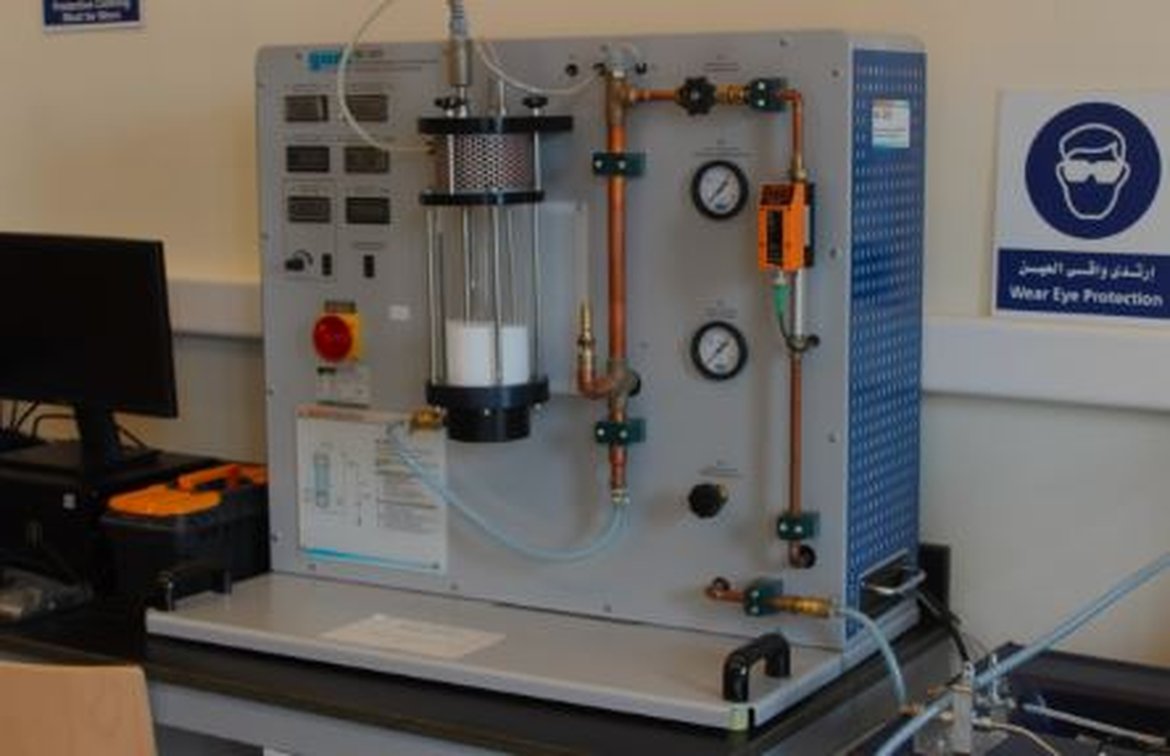
The Unit Operations Research Lab is a fundamental lab in the study of chemical processes, applying essential design equations in the design of various chemical processes such as absorption and stripping, distillation, solvent extraction, evaporative cooling, solid drying, crystallization, ion exchange, filtration, screening, sedimentation, computational methods in multistage and multicomponent systems, including particulate solids.
This lab aims to help students acquire practical knowledge of industrial unit operations. The experiments conducted in this lab include distillation, diffusion, absorption, stripping, evaporative cooling, crystallization, extraction of crystallized liquids, and mixing solid and liquid materials.
Main Objectives of the Lab:
- To help students acquire practical knowledge of fundamental chemical processes used in chemical industries.
- To conduct experiments that include distillation, diffusion, absorption, stripping, evaporative cooling, crystallization, extraction of crystallized liquids, and mixing solid and liquid materials.
- To apply mathematical equations and engineering models to design processes and evaluate performance in multistage and multicomponent systems.
- To promote interdisciplinary research by integrating chemical engineering, mechanical engineering, and environmental engineering to improve process design and system analysis.
Apparatus Used in the Lab:
- Continuous Distillation Column (UOP3CC): For performing and evaluating continuous distillation operations.
- Liquid/Liquid Extraction Unit (UOP5): For solvent extraction and separation of components in liquid phases.
- Gas Absorption Column (UOP7): For studying gas absorption and understanding the effect of gases on liquids.
- Continuous Solid/Liquid Extraction Pilot Plant: For applying extraction operations in both solid and liquid phases.
- Single Stage Evaporation Unit: For studying evaporation processes in detail and analyzing their efficiency.
The Unit Operations Research Lab provides a unique opportunity for students to engage in interdisciplinary research between chemical engineering, mechanical engineering, and environmental engineering. Through these experiments, students enhance their understanding of multistage system design and multicomponent systems, which require the integration of various chemical processes.
The lab encourages students to apply the theoretical concepts they learn in the classroom and solve practical challenges encountered in chemical industries when handling various materials.

The Control and Measurement Systems and Interdisciplinary Research Lab was established to assist students in understanding the theoretical concepts learned in courses related to control systems principles and measuring devices (transducers). This is achieved through a variety of practical experiments that allow students to apply their knowledge and gain hands-on experience.
In the control systems section, students explore open and closed-loop control systems and their applications, including level and flow control of fluids, electrical, electromechanical, and thermal systems, as well as position and speed control. The lab also provides practical exposure to the principles of controlling servomechanisms and conducting stability tests. Additionally, the lab covers topics such as system performance under the action of proportional (P), integral (I), and derivative (D) controllers, and measurements of both time and frequency response. Students will also simulate control systems using MATLAB and SIMULINK software to enhance their understanding of control system dynamics.
In the measuring devices section, the lab focuses on transducers and their construction. Students will experimentally identify static characteristics of sensing elements, such as ideal straight-line characteristics, non-linearity, sensitivity, hysteresis, resolution, and error bands. The experiments also demonstrate the loading effects in measurement systems, including the operation of deflection bridges and amplifiers, and show the process of analog-to-digital conversion and data acquisition.
The lab aims to integrate control systems theory and measurement systems with real-world applications, promoting interdisciplinary research by linking electrical engineering, mechanical engineering, and instrumentation. Students gain valuable insights into both the theoretical aspects and practical challenges of control and measurement systems, preparing them to solve complex engineering problems in a variety of industries.
Main Objectives:
- To provide practical experience in control systems and measuring devices through hands-on experiments.
- To explore open and closed-loop control systems, level and flow control, position and speed control, and servomechanisms.
- To perform stability tests and analyze system performance with P, I, and D controllers.
- To simulate control systems using MATLAB and SIMULINK for enhanced understanding of control theory.
- To study transducers, their construction, and experimental identification of static characteristics of sensing elements.
- To understand analog-to-digital conversion and data acquisition techniques used in measurement systems.
- To promote interdisciplinary research linking control systems, measurement systems, and engineering applications.
Apparatus Used in the Lab:
- Control Systems Trainer Kits: For practical control system applications such as fluid flow control, position control, and servomechanism control.
- Proportional, Integral, and Derivative Controllers: For tuning and testing controller performance.
- MATLAB and SIMULINK Software: For simulating control systems and analyzing system behavior.
- Transducer Test Equipment: For analyzing static characteristics and performance of sensing elements.
- Deflection Bridges and Amplifiers: For testing and demonstrating loading effects in measurement systems.
- Data Acquisition System: For capturing data and performing analog-to-digital conversion in measurement applications.
The Control and Measurement Systems Research Lab fosters interdisciplinary research by combining knowledge from electrical engineering, mechanical engineering, and instrumentation. The lab's experiments bridge the gap between control theory and measurement applications, allowing students to explore complex engineering problems across multiple domains.
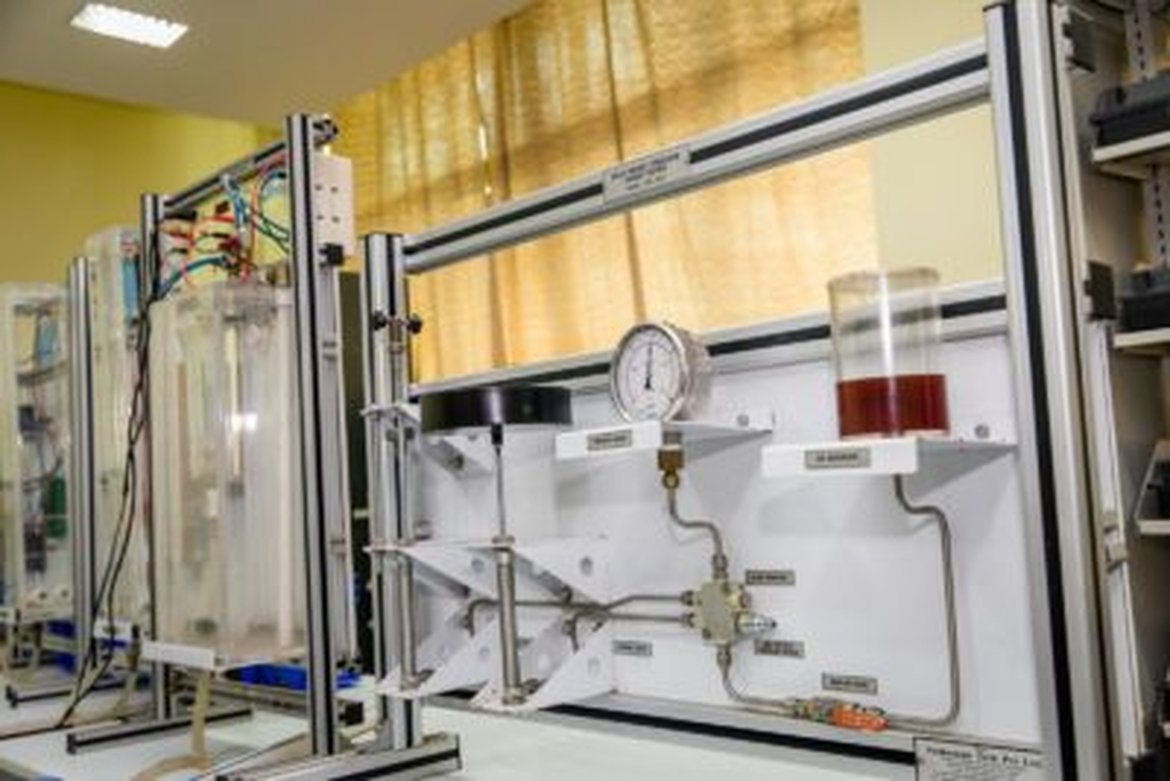
The Robotics and Automation Systems Research Lab is designed to provide students with hands-on experience in the programming and simulation of robotic industrial operations. This lab focuses on practical applications of CNC-Lathe and CNC milling machines, as well as the simulation of industrial processes using standard PLC (Programmable Logic Controllers) systems. Students will engage in experiments related to industrial automation, including assembly stations and product sorting applications, which are essential for real-world industrial processes.
In this lab, students will learn how to program robotic systems, control automated machinery, and simulate industrial tasks, gaining practical knowledge in the design and operation of automated systems. The lab fosters an understanding of how robotics and automation are integrated into modern manufacturing environments, with a focus on industrial applications and real-world problem-solving. The lab also emphasizes interdisciplinary research, combining principles from robotics, control systems, mechanical engineering, and electrical engineering to provide a comprehensive understanding of automated systems.
Main Objectives of the Lab:
- To equip students with the skills necessary for programming and simulating robotic industrial operations.
- To provide hands-on experience with CNC-Lathe and CNC milling machines in real-world applications.
- To introduce students to PLC programming for simulating industrial processes.
- To conduct experiments in industrial automation, focusing on assembly stations and product sorting.
- To promote interdisciplinary research by integrating concepts from robotics, control systems, electrical engineering, and mechanical engineering.
Apparatus Used in the Lab:
- CNC-Lathe Machines: For practical programming and operation of computer-controlled turning processes.
- CNC Milling Machines: For precise milling operations, programmed through CNC controls.
- Programmable Logic Controllers (PLC): For simulating and controlling industrial processes in automation systems.
- Robotic Arm Systems: For practical experiments in programming and controlling robotic arms for industrial tasks.
- Automation Equipment for Assembly Stations and Product Sorting: For studying industrial automation in assembly and sorting processes.

The Vibrations and Mechanical Systems Research Lab is designed to provide students with hands-on experience and practical knowledge related to the principles studied in the Vibrations course. The primary objectives of this lab are to investigate key vibration principles, practice with laboratory devices, and conduct experiments that complement and enhance the material covered in the Vibrations course.
Main Objectives of the Lab:
- To investigate and study the principles of vibrations in various mechanical systems.
- To practice on laboratory devices and instruments used in the study of vibrations.
- To conduct experiments that support and deepen understanding of the material learned in the Vibrations course.
- To enhance students’ ability to apply theoretical knowledge of vibrations to practical systems in mechanical engineering.
- To promote interdisciplinary research by integrating knowledge from various engineering fields, providing a holistic understanding of vibrations and their applications in industry.
The Vibrations and Mechanical Systems Research Lab fosters interdisciplinary research by integrating principles from mechanical engineering, dynamics, control systems, material science, and dynamic systems analysis. Students are encouraged to engage with research topics that explore the behavior of mechanical systems under vibrational forces, the design and optimization of damping systems, and the development of advanced vibration measurement techniques. This approach prepares students to contribute to innovations in fields such as automotive engineering, aerospace technology, and manufacturing systems.

The Concrete Materials Testing Research Lab is designed to provide students with hands-on experience in evaluating the physical properties and performance of aggregates, fresh concrete, and hardened concrete. This lab allows students to conduct essential tests to ensure that concrete materials meet the required specifications for use in construction projects. Through various experiments, students learn how to test, analyze, and interpret results related to aggregate gradation, air content, compressive strength, and other important concrete characteristics.
Main Objectives of the Lab:
- To ensure that aggregates, fresh concrete, and hardened concrete meet the required standards and specifications.
- To conduct experiments related to concrete mix design, strength testing, and durability analysis.
- To provide students with a thorough understanding of how the quality of concrete materials affects the overall performance of construction projects.
- To enhance students' practical knowledge in concrete testing and material characterization.
- To promote interdisciplinary research by connecting civil engineering principles with material science, offering students a holistic understanding of concrete materials.

The Environmental Engineering Research Lab is designed to introduce students to the fundamental principles of environmental chemistry and the testing of water and wastewater quality. This lab provides hands-on experience in performing experiments that are essential for understanding the quality and treatment of water, as well as monitoring wastewater. Through a series of practical experiments, students learn to measure and analyze key parameters such as pH, dissolved oxygen, alkalinity, conductivity, turbidity, and other water quality indicators.
The lab promotes interdisciplinary research by combining concepts from environmental engineering, chemistry, and water treatment technology. By engaging in experiments and research projects, students gain a deeper understanding of environmental issues, particularly in water and wastewater management. This knowledge is crucial for developing sustainable solutions to pressing environmental challenges.
Main Objectives of the Lab:
- To provide students with practical experience in testing water and wastewater quality parameters.
- To understand the basic concepts of chemistry and their application in environmental engineering.
- To measure and analyze essential water quality parameters, such as pH, dissolved oxygen, and turbidity, and assess their impact on water treatment processes.
- To offer students the opportunity to engage in interdisciplinary research, integrating environmental science, chemistry, and engineering in practical applications.
- To prepare students for careers in environmental engineering and water resource management by providing essential skills in water quality analysis.
Apparatus Used in the Lab:
- pH Meter: For measuring the acidity or alkalinity of water samples.
- Dissolved Oxygen Meter: For determining the concentration of oxygen dissolved in water.
- Conductivity Meter: To measure the electrical conductivity of water, indicating the presence of dissolved salts and minerals.
- Turbidity Meter: For measuring the cloudiness or haziness of water caused by suspended solids.
- Alkalinity Test Kit: For determining the buffering capacity of water.
- COD/BOD Testing Apparatus: For measuring the chemical and biological oxygen demand in wastewater samples.
- Water Quality Sampling Tools: For collecting and preparing water samples for analysis.
The Environmental Engineering Research Lab fosters interdisciplinary research by blending environmental engineering, chemistry, water treatment technologies, and sustainable practices. Students are encouraged to explore the interaction between chemical parameters and the environment, investigate water and wastewater treatment methods, and develop solutions to improve water quality and environmental protection. This approach prepares students to tackle complex environmental challenges and contribute to sustainable development.

The Fluid Mechanics and Hydraulics Engineering Research Lab is designed to provide students with practical experience in studying the principles of fluid mechanics and hydraulics. Through a series of hands-on experiments, students explore the fundamental concepts of fluid properties, hydrostatics, pressure measurement, velocity and flow measurement, and various flow measurement devices such as orifices, Venturi meters, and weirs. The lab also covers the study of flow in open channels and the operation of pumps.
This laboratory serves to bridge the gap between theoretical knowledge and real-world application, allowing students to observe and analyze fluid behavior in controlled experiments. The integration of interdisciplinary research encourages the application of fluid dynamics, hydraulic engineering, and mechanical principles to understand and solve practical engineering problems.
Main Objectives of the Lab:
- To investigate key principles of fluid mechanics studied in the fluid mechanics course.
- To learn how to measure essential parameters and properties in fluid mechanics, such as velocity, pressure, and flow.
- To provide hands-on experience with laboratory equipment and devices used in fluid mechanics experiments.
- To connect theoretical knowledge with practical applications in fluid mechanics and hydraulics.
- To develop an understanding of the behavior of fluids in different systems and environments, which is critical for designing and analyzing hydraulic structures and fluid systems.
The Fluid Mechanics and Hydraulics Engineering Lab encourages interdisciplinary research by integrating fluid dynamics, hydraulic engineering, and mechanical systems. Students are encouraged to explore how different fluid flow principles interact in real-world applications, such as in the design of water distribution systems, drainage systems, and hydraulic machines. The lab provides a comprehensive understanding of fluid behavior, which is essential for students pursuing careers in civil engineering, mechanical engineering, and environmental engineering.

The Highway Pavements and Materials Research Lab offers comprehensive training in the area of Asphaltic Materials and Paving Mixtures. It is fully equipped to perform a wide range of practical tests on road aggregates, bitumen, bituminous materials, bituminous mixes, and soil subgrade evaluation. Through hands-on experiments, students will gain the knowledge necessary to assess and evaluate materials commonly used in the construction of highways and roadways.
Main Objectives of the Lab:
- To familiarize students with the engineering properties and characteristics of materials used in highway construction, including aggregates, bitumen, and asphaltic mixes.
- To provide hands-on experience in mix design procedures, including the creation of bituminous mixtures and evaluations of their mechanical properties.
- To conduct and analyze field and laboratory tests to determine the suitability and performance of materials for highway pavements.
- To connect theoretical knowledge with practical applications by using lab-based tests and exercises that mirror real-world engineering practices.
- To encourage interdisciplinary research that integrates materials engineering, civil engineering, and transportation engineering principles in solving real-world pavement and road construction issues.
Apparatus Used in the Lab:
- California Bearing Ratio (CBR) Apparatus: For testing the load-bearing capacity of subgrade soils.
- Penetration Testing Apparatus: To measure the consistency of bituminous materials.
- Saybolt Universal/Furol Viscometer: For measuring the viscosity of bituminous materials.
- Flash and Fire Point Apparatus (Cleveland Open Cup Method): To test the flammability of bituminous materials.
- Ring and Ball Apparatus: To measure the softening point of asphalts and tar pitches.
- Ductility Testing Apparatus: For determining the ductility of bituminous materials.
- Marshall Stability Test Apparatus: For designing and testing asphalt concrete mixtures, including voids analysis.
- Asphalt Binder Extraction Equipment: For extracting and analyzing binder content in asphaltic mixes.
- Skid Resistance Tester: To evaluate the frictional properties of road surfaces.
The Highway Pavements and Materials Research Lab fosters interdisciplinary research by integrating materials science, civil engineering, and transportation engineering concepts. Students are encouraged to explore the interactions between material properties and highway performance, analyze how materials respond to different environmental and load conditions, and investigate ways to improve road safety, durability, and sustainability. The lab provides essential tools and knowledge for solving complex challenges in the pavement engineering field, preparing students for careers in transportation infrastructure and materials engineering.

The Mechanics of Materials Research Lab provides students with the opportunity to explore the fundamental concepts of equilibrium in force systems, stress and strain relationships, and the mechanical properties of materials. This lab offers hands-on experiments designed to support the principles learned in the Mechanics of Materials course, with a focus on the application of equilibrium principles to structures such as beams and rigid bodies. The lab emphasizes practical applications of stress analysis, shear and bending forces, and the deflection of materials, offering a comprehensive understanding of material behavior under various loading conditions.
Students also investigate how material properties such as strength, deformation, and elasticity can be measured through experimental methods. The lab promotes interdisciplinary research, connecting materials science, structural engineering, and mechanical principles to solve real-world problems in material behavior and structural design.
Main Objectives of the Lab:
- To investigate and apply principles of strength mechanics studied in the Mechanics of Materials course.
- To learn how to measure key parameters and properties related to material behavior, such as stress, strain, shear, and bending forces.
- To connect theoretical knowledge with practical applications through hands-on experiments involving real materials and mechanical systems.
- To encourage interdisciplinary research in understanding the mechanical properties of materials and their behavior in various structural applications.
Apparatus Used in the Lab:
- Rubber in Shear Apparatus: For testing the shear properties of rubber materials.
- SM1 Torsion Testing Machine: For applying torsional loads to materials and measuring the resulting stresses.
- SM100 Universal Testing Machine: For performing tension and compression tests on materials to determine their mechanical properties.
- Combined Bending and Torsion Apparatus: For examining the combined effects of bending and torsion on structural materials.
- Deflection of Curved Bars Apparatus: For measuring the deflection of curved bars under loading.
- Extension of Wires Apparatus: For measuring elongation and calculating the Young’s Modulus of materials.
- Suspension Cable Apparatus: For studying the tension distribution and deformation in suspension cables.
- Deflection of Beams Apparatus: For measuring beam deflection under applied loads and studying the relationships between material, beam geometry, and applied loads.
- Equilibrium of a Rigid Body Apparatus: For demonstrating equilibrium principles in rigid body systems.
- Simple Suspension Bridge Apparatus: For analyzing the forces acting on a suspension bridge.
- Forces in a Truss Apparatus: For studying the internal forces in truss structures.
- Equilibrium of a Beam Apparatus: For analyzing beam equilibrium under different loading scenarios.
- Equilibrium of Forces Apparatus: For experimenting with static systems to study the balance of forces.
The Mechanics of Materials Research Lab fosters interdisciplinary research by incorporating materials science, structural engineering, and mechanical principles. Students are encouraged to explore the behavior of materials under various loading conditions, assess their mechanical properties, and design solutions for structural challenges. The lab provides the tools and knowledge necessary to understand the complexities of material behavior, making it an essential resource for students pursuing careers in civil engineering, mechanical engineering, and structural design.
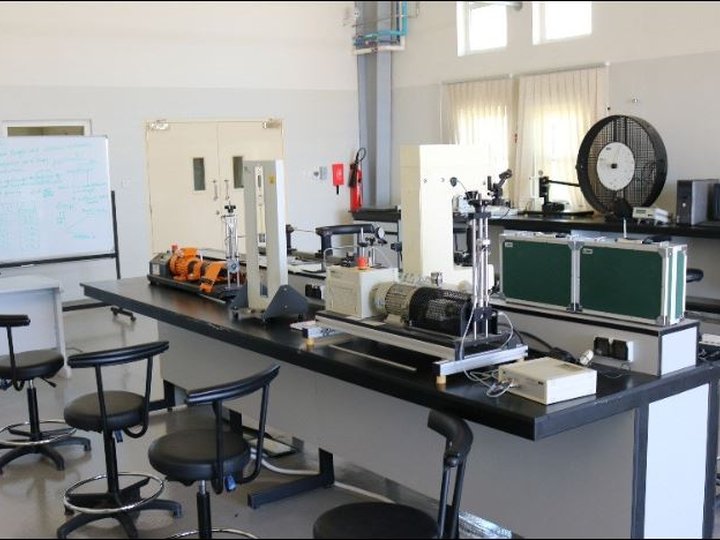
The Soil Mechanics Research Lab is designed to provide students with hands-on experience in testing the physical properties of soil in accordance with international standards. The lab supports students' understanding of geotechnical engineering principles and allows them to investigate soil behavior under various conditions. By performing a range of laboratory tests, students gain valuable knowledge essential for the geotechnical engineering profession. These tests help in determining soil characteristics that influence the design and construction of foundations, pavements, and other infrastructure projects.
The lab emphasizes interdisciplinary research by incorporating principles from geotechnical engineering, material science, and structural engineering to evaluate soil properties and their implications for construction and engineering applications. This approach allows students to apply theoretical knowledge to real-world challenges, ensuring their readiness for professional practice in geotechnical fields.
Main Objectives of the Lab:
- To investigate and measure the physical properties of soil, such as grain size, compaction, and permeability, in line with geotechnical engineering standards.
- To develop hands-on skills in conducting soil tests and analyzing soil behavior in various environmental and loading conditions.
- To connect theoretical knowledge with practical applications, supporting the geotechnical engineering profession.
- To foster interdisciplinary research in understanding the impact of soil properties on engineering projects, construction techniques, and infrastructure development.
The Soil Mechanics Research Lab encourages interdisciplinary research by integrating principles from geotechnical engineering, material science, and structural engineering. Students can apply the knowledge gained in soil testing to real-world engineering challenges, such as foundation design, infrastructure development, and environmental sustainability. The lab prepares students to approach complex engineering problems through practical, research-based solutions.
Main Objectives of the Lab:
- To offer students practical experience with surveying equipment and techniques essential for various engineering and geographic applications.
- To help students understand the theory and application of surveying methods, instruments, and software used in the preparation of accurate surveying plans.
- To allow students to connect theoretical knowledge with practice, supporting their overall education in surveying and related disciplines.
- To provide an opportunity for interdisciplinary research by collaborating across civil engineering, architecture, urban planning, geography, and other related fields.
Main Equipment in the Lab:
- Chain Surveying Tools: Tapes, ranging rods, plumb bobs, etc., for basic distance and direction measurements.
- Levels: Both automatic and electronic digital levels for precise elevation and height measurements.
- Theodolites: Used for measuring angles in both horizontal and vertical planes to determine positions and heights.
- Total Stations: For precise distance and angle measurements, allowing for more advanced survey work and data collection.
- Planimeters: For measuring areas on maps or plans, useful for calculating the size of surveyed land.
- Basic Photogrammetric Equipment: Includes a mirror stereoscope for interpreting aerial photographs and generating maps or 3D images.
- GPS Receivers: For global positioning and real-time location data collection, aiding in large-scale surveying projects and geospatial studies.
- Personal Computers: The lab contains more than 20 computers equipped with appropriate surveying and GIS software for data analysis, plan creation, and printing of surveying results.
The Surveying Research Lab encourages interdisciplinary research by supporting collaborative projects across various fields, including civil engineering, architecture, urban planning, geography, and environmental sciences. The lab provides students with opportunities to work on real-world surveying projects that involve a mix of these disciplines. Students gain experience in applying modern surveying technologies, such as GPS, total stations, and photogrammetry, to solve complex problems in urban planning, construction, land development, and geographic mapping.

The Animal and Plant Tissue Culture Research Lab is a vital facility where advanced techniques in biological research are applied to study and develop animal and plant cells and tissues. The lab is equipped with various high-tech instruments that support experiments such as tissue culture, stem cell research, and environmental effects on cell growth, among other biological applications.
Instruments:
-
10-Liter General Purpose Water Bath: This instrument is used to precisely regulate the temperature of samples during experiments that require a consistent heat source.
-
CO2 Incubator: A critical tool for the growth and maintenance of cells and tissues in a controlled environment with a stable CO2 concentration, mimicking natural conditions for cell growth.
-
Balance: A highly accurate scale used to measure small quantities of substances or solutions required for biological experiments.
-
Centrifuge: This device is used to separate components in biological samples through centrifugal force, such as separating cells or proteins.
-
Cross Linker & Trans Illuminator: Used for UV-induced crosslinking reactions and DNA or gene analysis through fluorescent illumination.
-
Esco Safety Cabinet: A safety enclosure that prevents contamination during the handling of biological samples, providing a sterile working environment.
-
Hot Bead Sterilizer: A device used for sterilizing biological tools by exposing them to high temperatures, ensuring the elimination of microorganisms.
-
Inverted Fluorescence Microscope: A microscope that allows for the examination of live cells and tissues using fluorescence, enabling detailed observation of biological components.
-
Micropipettes / Electronic Micropipettes: Precise tools for transferring tiny volumes of liquids in biological experiments, essential for preparing samples or transferring cells.
-
Microscope: A standard tool for observing biological samples in detail, allowing for magnified views of cells and tissues.
-
Vortex: This instrument is used for rapidly mixing biological samples to ensure uniformity in the sample preparation.
These instruments play a fundamental role in interdisciplinary research by combining various scientific fields such as biology, chemistry, physics, and engineering. Techniques like animal and plant tissue culture require deep knowledge across multiple disciplines, including biochemistry, molecular biology, and environmental sciences. By integrating these tools, researchers are able to conduct comprehensive studies that span genetics, medical applications, agriculture, and disease treatment, contributing to a better understanding of how to optimize biological and ecological systems.
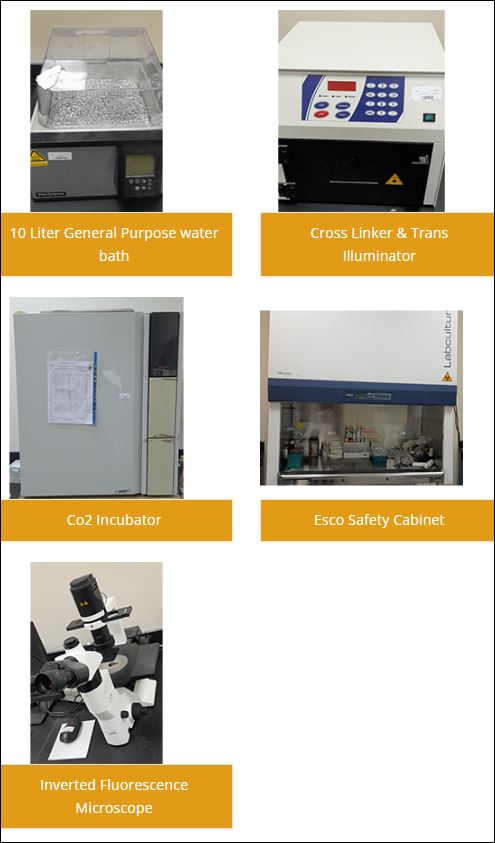
The Molecular Biology and Plant Taxonomy Research Lab is a specialized research facility focused on molecular biology, plant taxonomy, and the study of biological activities of medicinal plants and chemical compounds. This lab is dedicated to research purposes, where no courses are taught, but it occasionally hosts graduation projects and research by graduate students. The lab's primary goal is to explore the molecular aspects of plant biology, examine the genetic makeup of plants, and investigate the therapeutic properties of plants and their chemical constituents.
Instruments Used:
-
Stereo-Microscope: A tool used for observing larger specimens such as plant tissues and small organisms at low magnification, essential for detailed study of plant structure and taxonomy.
-
Micro-Centrifuge: A compact device used to separate components of biological samples by spinning them at high speeds, useful for isolating nucleic acids, proteins, and other biomolecules.
-
Gel Electrophoresis System: An essential tool for separating and analyzing DNA, RNA, and proteins based on their size and charge, allowing for the study of genetic material in plants and microorganisms.
-
Gel Electrophoresis Power Supply: Works in conjunction with the electrophoresis system to provide the necessary electrical current to run the gels and separate biomolecules.
-
Vortex: Used for rapidly mixing liquid samples to ensure even distribution, critical for experiments involving solutions or cell suspensions.
-
Hot Plate with Magnetic Stirrer: Used to heat liquids and stir solutions, often necessary for preparing samples or chemical compounds in biological experiments.
-
Incubator: Maintains a stable environment with controlled temperature and humidity, supporting the growth of cells, microorganisms, or plant tissues for molecular studies.
-
Water Bath: A device used for maintaining samples at a specific temperature for long periods, frequently used in experiments requiring consistent heat exposure.
-
Analytical Balance: A highly sensitive scale used to measure small quantities of substances for experiments, essential for precision in molecular biology and plant chemical analysis.
-
UV Transilluminator: Used to visualize nucleic acids, proteins, or other fluorescently labeled compounds in gels after electrophoresis, making it a critical tool for molecular biology research.
-
Micropipettes: Precision instruments for measuring and transferring small volumes of liquids, fundamental for DNA/RNA analysis, cell culture work, and compound preparation.
-
Refrigerator: Maintains samples at low temperatures to preserve their integrity, essential for storing biological reagents, plant extracts, and chemical compounds.
-
UV Lamp: Provides ultraviolet light for various applications in molecular biology, such as sterilization, DNA visualization, and other biochemical experiments.
-
Compound Microscope: A versatile tool for observing specimens at higher magnifications, allowing researchers to analyze cellular and molecular structures in detail.
-
Fume Hood: Provides a ventilated workspace for handling volatile chemicals or toxic compounds, ensuring the safety of researchers during experiments involving chemical analysis.
This lab is a prime example of interdisciplinary research, where diverse scientific fields converge to enhance our understanding of plant biology, molecular mechanisms, and the potential medicinal properties of plants. By combining molecular biology, plant taxonomy, pharmacology, and chemistry, this lab fosters research that spans multiple disciplines. Researchers in the lab not only explore the genetic and biochemical profiles of plants but also investigate their potential in drug discovery and sustainable agricultural practices.
The integration of molecular biology techniques with plant taxonomy allows for the detailed analysis of plant species, their genetic diversity, and their possible therapeutic properties. Furthermore, by studying the chemical compounds within plants, researchers can contribute to fields like pharmacology and natural product chemistry, with implications for medicine and agriculture. This multidisciplinary approach enables the lab to advance scientific knowledge and innovation in areas such as plant-based pharmaceuticals, genetic engineering, and environmental conservation.

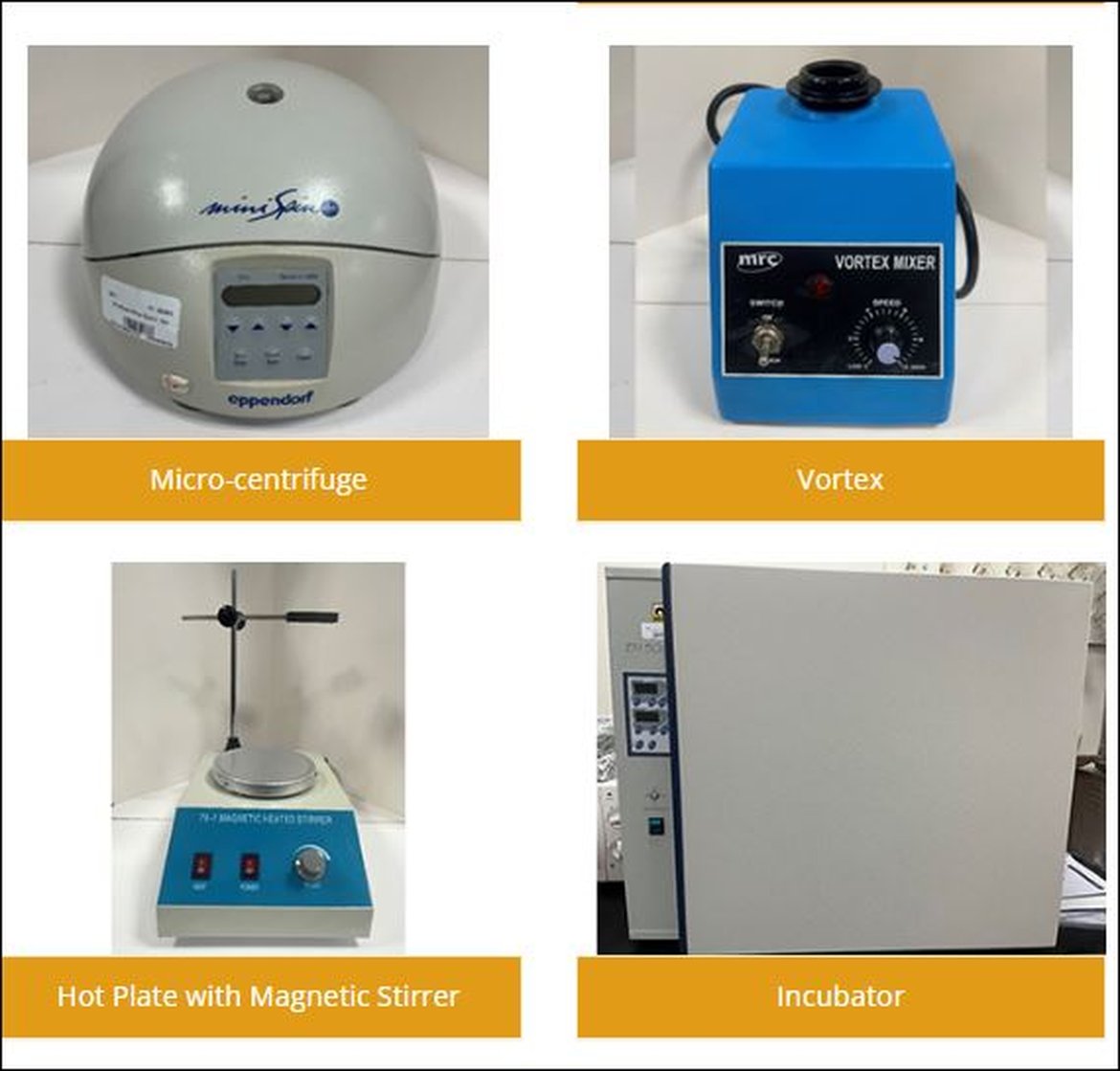
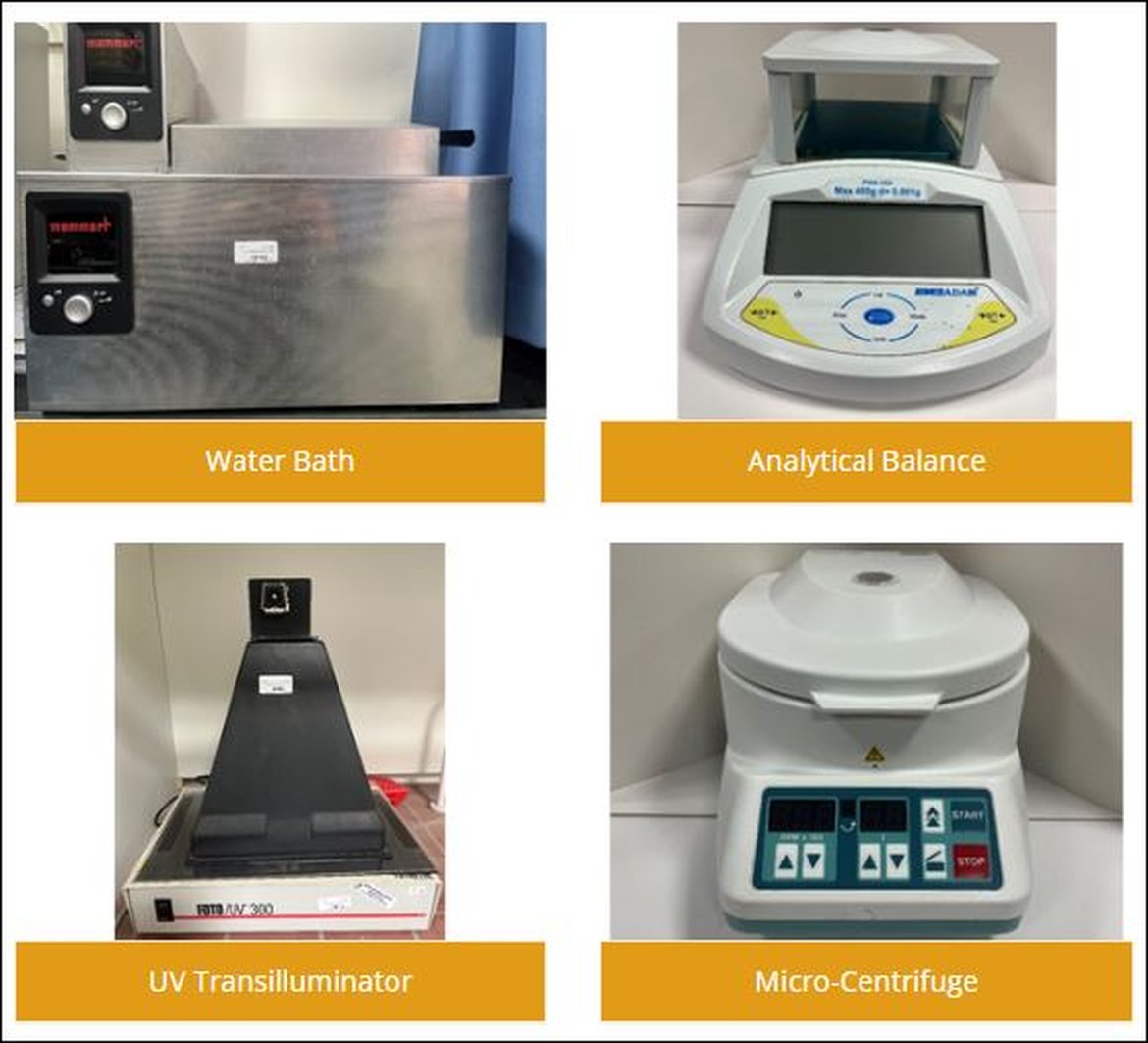
The Microbiology and Molecular Biology Research Lab is a dedicated research facility that focuses on microbiology and molecular biology techniques to explore microorganisms, genetic material, and biochemical processes. The lab is equipped with cutting-edge instruments that allow researchers to analyze and manipulate DNA, RNA, proteins, and microbial cultures with precision. This lab plays a crucial role in advancing knowledge in areas like microbial genetics, molecular diagnostics, bioengineering, and environmental microbiology.
Instruments Used:
-
Applied Biosystems ABI 7500 Real-Time PCR Catalog:A high-precision tool for real-time polymerase chain reaction (PCR) analysis, enabling the quantification of DNA, RNA, and gene expression. This instrument is essential for gene analysis, diagnostics, and environmental studies.
-
Autoclave: A device used to sterilize equipment, culture media, and other materials by applying high-pressure steam, ensuring that biological contaminants are removed before experimentation.
-
Incubator: Maintains controlled temperature conditions for the cultivation of microorganisms, cells, or other biological samples. This is crucial for microbiological and molecular biology experiments.
-
Centrifuge: Used for separating components of a sample by spinning it at high speeds, commonly used for separating cellular components, proteins, and nucleic acids in molecular biology experiments.
-
Deep Freeze: A storage unit that maintains ultra-low temperatures for the preservation of biological samples, reagents, or microbial cultures, preventing degradation.
-
Ice Maker: Produces ice for cooling samples, preserving enzymes, and maintaining temperature-sensitive experiments or reagents.
-
Hot Plate: A device used for heating liquids or solids to a specific temperature in biological experiments, providing controlled conditions for chemical reactions and sample preparation.
-
Micropipettes: Precision instruments used to transfer very small volumes of liquids, essential for DNA/RNA extraction, PCR preparation, and other molecular biology techniques.
-
Milirock Technology, Benchtop Manifold Freeze-Dryer Unit: A freeze-dryer used for the preservation of biological samples, pharmaceuticals, and chemicals by removing moisture at low temperatures, commonly used for lyophilization.
-
Multi Doc It UV System: A system used to capture and analyze images of UV-transilluminated samples, often used in molecular biology to detect nucleic acids or proteins in gels.
-
Nanodropper, Jenway Model Genova Nano Single Beam, Scanning, UV/Visible Range: A high-performance spectrophotometer used for measuring nucleic acid concentrations, protein quantification, and other UV/visible absorbance analyses in molecular biology.
-
Sonicator: Used to disrupt cells or tissues by applying ultrasonic sound waves, aiding in cell lysis, DNA extraction, and other molecular biology techniques.
-
Ultra Violet Sterilization Cabinet: A cabinet that utilizes UV light to sterilize equipment and materials, ensuring that biological samples remain uncontaminated and reducing the risk of cross-contamination.
-
pH Meter: A device used to measure the acidity or alkalinity of solutions, which is critical in maintaining optimal conditions for microbial growth and molecular reactions.
-
Laminar Flow H Airflow 152x60x220: A clean bench with controlled airflow used to prevent contamination during the handling of biological samples. It ensures a sterile working environment, especially for cell culture and microbial research.
-
Rotary Evaporator, Cat: RE300: A device used for evaporating solvents in a sample under reduced pressure, essential for purifying or concentrating compounds in microbiology and molecular biology experiments.
This Microbiology and Molecular Biology Research Lab is a prime example of interdisciplinary research, as it integrates multiple scientific fields such as microbiology, molecular biology, chemistry, physics, and environmental science. The combination of microbiological techniques with molecular biology approaches enables researchers to study microorganisms at a genetic and biochemical level, allowing for a deeper understanding of their behavior, genetics, and potential applications in various fields.


The Microbiology and Preparation Lab is designed for microbiological research, sample preparation, and the cultivation of microorganisms. It is equipped with essential instruments that enable researchers to study microbial behavior, growth, and interactions under controlled conditions. This lab is dedicated to exploring various aspects of microbiology, from bacterial cultures to sample preparation for advanced molecular analysis. The lab is an essential part of interdisciplinary research that spans microbiology, biochemistry, molecular biology, environmental science, and other related fields.
Instruments Used:
-
Safety Cabinet: A critical piece of equipment used to ensure a sterile environment when working with hazardous or infectious materials, protecting both the researcher and the samples from contamination.
-
Microbiology Incubator: Used for maintaining optimal temperature conditions for the growth of microorganisms. It provides a controlled environment for the culture of bacteria, fungi, and other microbes.
-
Incubator + Shaker: This combined unit is used to incubate microbial cultures while simultaneously shaking them. The shaking enhances nutrient exchange and aeration, which is particularly important for growing bacteria and yeast.
-
Fluorescent Microscope with Camera: A microscope equipped with fluorescence capabilities, allowing researchers to visualize specimens that are labeled with fluorescent dyes. This is crucial for studying microbial interactions and the presence of specific cellular components.
-
Dissecting Microscope with Camera: A low-magnification microscope used for observing larger biological specimens, such as tissues or whole microorganisms. The attached camera helps document findings for further analysis.
-
Trinocular Microscope with CCD Camera: A microscope that offers high magnification for detailed study of microorganisms or cells. The CCD camera allows researchers to capture and document images for analysis and presentation.
-
Ordinary Microscope with Visi Cam: A standard microscope used for general observation of microbial samples. The Visi Cam feature allows for real-time digital capture of images for further analysis.
-
UV Cabinet: A sterilization unit that uses ultraviolet (UV) light to disinfect tools, equipment, or surfaces. This is especially important for preventing microbial contamination in samples and experiments.
-
Water Bath with Shaker: Used for maintaining samples at a constant temperature while shaking them gently. It is particularly useful for growing cultures and conducting biochemical reactions.
-
Vortex: A device that rapidly agitates solutions in test tubes or vials, ensuring uniform mixing of contents. This is essential for sample preparation and for ensuring homogeneous solutions in experiments.
-
pH Meter: An instrument used to measure the acidity or alkalinity of solutions, crucial for maintaining the optimal pH for microbial growth and reactions in biochemical experiments.
-
Micropipette Set: A set of precision instruments used for transferring small amounts of liquids. Essential for accurate preparation of samples, microbial cultures, and conducting experiments in molecular biology.
-
Multichannel Micropipette: A pipette with multiple channels that allows researchers to transfer multiple samples simultaneously, improving efficiency in experiments that require precise liquid handling.
-
Pipette Filler: A tool used to fill micropipettes with liquids, ensuring accuracy and preventing contamination during the sample transfer process.
-
Microwave: A common laboratory tool used for rapid heating of samples, sterilization, or the preparation of microbial cultures and solutions.
-
Refrigerator: A cooling unit used to store biological samples, reagents, and culture media at low temperatures to prevent degradation and preserve sample integrity.
The Microbiology and Preparation Lab plays a vital role in interdisciplinary research by bridging microbiology with various scientific domains such as molecular biology, biochemistry, environmental science, and biotechnology. The combination of microbiological techniques with advanced molecular tools, such as fluorescent microscopes, micropipettes, and pH meters, allows researchers to conduct detailed studies of microbial growth, genetics, and behavior at both the cellular and molecular levels.
By integrating tools for microbial culture and analysis with molecular techniques, this lab contributes to research in fields such as:
- Medical Microbiology: Studying microbial pathogens, their resistance mechanisms, and potential treatments or vaccines.
- Environmental Microbiology: Investigating the role of microorganisms in ecosystems, including bioremediation and nutrient cycling.
- Biotechnology: Developing microbial-based solutions for industrial applications, such as biofuel production or waste treatment.
- Genetic Engineering: Using microbial models to explore genetic modifications, gene expression, and protein production.
Additionally, the lab supports collaborative research efforts that span multiple disciplines, fostering innovations in fields like disease diagnosis, drug development, and sustainable agriculture. Researchers are able to investigate how microbes interact with their environment, explore the effects of environmental factors on microbial behavior, and apply this knowledge in practical, real-world contexts. The interdisciplinary approach in this lab enhances scientific discoveries and contributes to solving global challenges related to health, agriculture, and the environment.
The General Biology and Research Lab is a comprehensive facility designed to support a wide range of biological research across various fields, including general biology, animal and plant physiology, developmental biology, and ecology. The lab provides an environment for researchers to explore the fundamental processes of living organisms, conduct experiments, and advance scientific knowledge in a variety of biological disciplines. This interdisciplinary approach fosters collaboration between different biological subfields, enabling researchers to gain a deeper understanding of biological systems at the molecular, cellular, and organismal levels.
Instruments Used:
-
Balance: A precise instrument used to measure the mass of biological samples, chemicals, or reagents with high accuracy. Essential for experiments that require precise measurements.
-
Benchtop Biosafety Cabinet: A safety enclosure used to protect both the researcher and the samples from contamination. This is vital for handling biological materials, particularly hazardous or sensitive organisms.
-
Binocular Microscope: A basic microscope used for observing biological specimens at low to medium magnification. It is crucial for general observations of cells, tissues, and organisms.
-
Blood Pressure Meter: A device used to measure the blood pressure of animals or humans, commonly used in animal physiology experiments to study cardiovascular health.
-
Digital Kymograph: A device used to measure and record physiological processes, such as muscle contractions or respiratory movements, providing data on biological activities in real-time.
-
Digital Micropipette: A highly precise tool for transferring small volumes of liquids. It is essential for molecular biology experiments, such as DNA/RNA preparation and enzyme assays.
-
ECG (Electrocardiogram): An instrument used to measure and record the electrical activity of the heart, important in animal physiology and medical research.
-
Electric Balance (0.01 gm to 200 gm): A high-precision scale used for measuring small to large amounts of biological samples or reagents. Essential for experiments requiring exact mass measurements.
-
Electrophoresis Chamber-Midi-Horizontal Electrophoresis Unit (HU13): Used for separating nucleic acids or proteins based on their size and charge in horizontal gel electrophoresis experiments.
-
Electrophoresis Unit Dual Vertical Mini Gel: A vertical electrophoresis system used for protein and nucleic acid separation, enabling high-resolution analysis of biological samples.
-
Eppendorf Eporator System: A system used for electroporating cells, allowing researchers to introduce genetic material into cells for genetic studies and biotechnology applications.
-
Fume Hood: A ventilation system used to safely work with volatile chemicals and gases, ensuring that no hazardous fumes contaminate the work environment.
-
Horizontal Gel Electrophoresis Unit: A unit used for separating DNA, RNA, or proteins using an electric field in horizontal gel electrophoresis, a crucial technique for molecular biology.
-
Hot Plate with Magnetic Stirrer: A heating device that allows for both precise temperature control and mixing of solutions in biological experiments.
-
Incubator: A controlled environment chamber used to maintain specific temperature conditions for the growth and cultivation of cells, microorganisms, or plant tissues.
-
Micropipette: A standard precision tool used for transferring small, accurate volumes of liquids in laboratory experiments, essential for molecular biology and biochemistry research.
-
Microwave: A laboratory microwave used for rapid heating, sterilization, or sample preparation in biological experiments.
-
Power Supply: A unit that provides the necessary electrical current for electrophoresis units and other instruments, ensuring proper functioning of experiments.
-
Refrigerator: A cooling unit used for storing biological samples, reagents, and media to preserve their integrity and prevent degradation.
-
Spectrophotometer: An instrument used to measure the absorbance of light by a sample, often used to quantify concentrations of biomolecules like DNA, RNA, or proteins.
-
ThermoMixer: A device used to mix and heat samples simultaneously, making it ideal for reactions that require temperature control and agitation.
-
T Professional Standard Gradient 96-Well: A thermal cycler used in PCR (Polymerase Chain Reaction) experiments, allowing for temperature gradients to optimize DNA amplification.
-
Vortex: A device used to agitate liquid samples, ensuring homogeneity in experiments requiring precise mixing.
-
Water Bath & Shaker: A combination unit used to maintain samples at a constant temperature while shaking gently. It is used for cell culture, enzyme reactions, and molecular biology assays.
-
Oven: A device used to dry or heat biological samples at controlled temperatures, often used for preparing samples or sterilizing equipment.
-
Centrifuge: A high-speed instrument used to separate components of biological samples based on their density, crucial for isolating cellular components, proteins, and nucleic acids.
-
MiniSpin Plus Eppendorf Centrifuge: A compact centrifuge used for small-volume sample preparation, ideal for DNA/RNA extraction and other molecular biology tasks.
The General Biology and Research Lab plays a key role in facilitating interdisciplinary research by providing a platform for researchers to integrate diverse biological disciplines such as animal physiology, plant physiology, developmental biology, ecology, and general biology. The combination of tools and techniques from molecular biology, genetics, ecology, and physiology enables scientists to tackle complex biological questions and bridge multiple research fields.
By using advanced instruments like the spectrophotometer, electrophoresis units, and incubators, researchers can study everything from gene expression and protein analysis to ecological interactions and environmental impact on organisms. For example, animal physiology studies benefit from the use of ECGs, blood pressure meters, and kymographs, while plant physiology can be explored using incubators, spectrophotometers, and water baths.
This interdisciplinary approach fosters collaborative research that spans areas such as:
- Ecology and Environmental Science: Studying the interactions between organisms and their environment, and understanding ecological processes.
- Medical Research: Using animal physiology and molecular biology techniques to develop new treatments, diagnostics, and medical technologies.
- Biotechnology: Exploring plant and animal systems for potential applications in agriculture, healthcare, and industry.
- Genetics and Genomics: Using electrophoresis, PCR, and other molecular tools to understand gene function, inheritance, and molecular mechanisms.
Overall, this lab enables a holistic approach to biological research, where different scientific disciplines intersect, allowing for groundbreaking discoveries in health, environmental sustainability, and biotechnology. Through interdisciplinary collaboration, the lab contributes to innovations that have practical applications across many sectors, from medicine and agriculture to conservation and biotechnology.

The Research Lab for Instrumentation and Measurements is a specialized facility focused on providing accurate and reliable measurements for a wide range of scientific and engineering applications. Equipped with advanced instruments, this lab allows researchers to measure electrical signals, power, voltage, and resistance, as well as generate and analyze waveforms for experimental purposes. It is an essential resource for both theoretical and applied research in fields such as electrical engineering, physics, and applied sciences, supporting interdisciplinary research initiatives.
Instruments Used:
-
AC/DC Power Supply: A versatile power source providing both alternating current (AC) and direct current (DC) for experiments requiring different power inputs. It is fundamental for powering electronic circuits and devices during research.
-
Digital Multimeters: Precision instruments used to measure electrical parameters like voltage, current, and resistance. They are essential tools for ensuring accurate electrical measurements in experiments and designs.
-
Digital Power Supply: A controlled power supply providing stable, adjustable output for electrical testing and experimentation. It powers devices and circuits in a wide range of research applications.
-
Function Generator: This device generates various types of waveforms (sine, square, triangle) at adjustable frequencies. It is crucial for testing and stimulating circuits, especially in signal processing and communication research.
-
Oscilloscope: A device used to visualize and analyze electrical signals, showing how voltage changes over time. It is indispensable for examining waveforms, timing characteristics, and troubleshooting circuits in real-time.
-
Four Probe: A technique for measuring the resistance of materials with high accuracy, primarily used in material science and electrical conductivity research to get precise resistance measurements without interference from contact resistance.
The Research Lab for Instrumentation and Measurements plays a vital role in facilitating interdisciplinary research by providing essential tools for precise measurements and analysis across various fields. Its range of instruments supports numerous disciplines and contributes to both theoretical and practical applications.
-
Electrical Engineering and Physics:
The lab supports electrical engineering research by enabling precise measurement of electrical parameters and testing of circuits and systems. In physics, the instruments help explore the fundamental properties of materials and electrical phenomena. -
Material Science:
The Four Probe method is especially important for material science research, where accurate resistance measurements are crucial for studying the conductivity and performance of materials in electronics and other applications. -
Signal Processing and Communication:
The Function Generator and Oscilloscope are key tools in signal processing and communications research. They allow researchers to develop, analyze, and optimize waveforms used in modern communication systems, radar, and imaging technologies. -
Biomedical Research:
The Oscilloscope and Digital Multimeters are applied in biomedical engineering research to develop and test medical devices and sensors that rely on electrical measurements, such as ECG monitors and wearable health devices. -
Renewable Energy Research:
The AC/DC Power Supply and other electrical measurement tools are essential for testing and optimizing renewable energy systems like solar panels and wind turbines, helping researchers evaluate performance, energy output, and efficiency.
The Research Lab for Instrumentation and Measurements serves as a bridge for various research domains, encouraging collaboration and the integration of new technologies and techniques across disciplines. Its role in interdisciplinary research fosters innovations in electronics, materials science, biomedical engineering, energy systems, and beyond.

The Research Lab for High Energy Physics (HEP) in Palestine is a state-of-the-art facility designed to advance scientific studies in the field of high energy physics. This lab is equipped with a high-performance computing infrastructure that includes 1,200 core units, 50 worker nodes, and 8 data servers, providing immense computational power equivalent to 1,000 advanced computers. The lab also has 400 TB of storage, enabling the handling and processing of large volumes of data generated in high-energy physics experiments.
The equipment was donated by the European Center for Nuclear Research (CERN) in Geneva, Switzerland, as part of an agreement signed with An-Najah National University during the third Winter School in High Energy Physics in Palestine (WISHEPP). The lab's mission is to contribute to global research in high energy physics, particularly in particle physics, while serving as a hub for scientific collaboration in the region.
The Research Lab for High Energy Physics in Palestine exemplifies interdisciplinary research by combining physics, computational science, engineering, and data science to push the boundaries of knowledge in high energy physics. The lab’s high computing power allows researchers to simulate and analyze complex physical phenomena, such as particle collisions and subatomic interactions.
The interdisciplinary nature of the lab facilitates significant collaboration across various scientific fields:
-
Physics and Computational Science:
High energy physics involves complex simulations and data analysis, which are enabled by the lab’s powerful computational resources. Researchers use advanced computational techniques to model particle behavior and analyze the vast datasets produced by experiments. -
Engineering and Technology:
The lab’s infrastructure and computing systems require ongoing support and innovation from engineers to ensure the proper operation of hardware, software, and network systems, collaborating closely with physicists to optimize data processing and storage. -
Data Science and Big Data Analytics:
With the large-scale data generated by experiments, data science plays a critical role in processing and interpreting these datasets. Researchers apply statistical methods, machine learning, and artificial intelligence to analyze and extract valuable insights from the data, leading to new discoveries in particle physics. -
Collaborative Research:
The lab fosters collaboration with leading research institutions like CERN, allowing Palestinian researchers to engage in global scientific projects. This collaboration enables knowledge exchange and integrates Palestinian researchers into the international scientific community.
The Research Lab for Advanced Material Science is a cutting-edge facility dedicated to the study, preparation, and experimentation of various materials in order to discover their unique properties and potential applications. The lab is equipped with a wide range of scientific research devices and instruments necessary for the synthesis of new materials and the examination of their characteristics under different conditions. This lab plays a crucial role in advancing material science research by exploring the physical, chemical, and mechanical properties of materials, while also studying their behaviors in various applications such as electronics, energy storage, and nanotechnology.
Instruments Used:
-
Hydraulic Manual Pellet Press Machine 12ton: This machine is used to apply pressure to materials in order to form pellets. It is essential for preparing samples for further testing and characterization, particularly in studies of material compactness and density.
-
Electric Dry Grain Mill Grinder: A powerful grinder used for reducing materials into finer particles, making it an essential tool for the preparation of powders and composites in material synthesis.
-
Coffee Grinder CG9430: A smaller grinder used for finer material grinding, offering more precise control for smaller-scale experiments or when working with delicate substances.
-
Hotplate Magnetic Stirrer, BS4H: This device provides heat and magnetic stirring, essential for mixing materials at precise temperatures and ensuring uniformity in chemical reactions during material preparation.
-
Smart Inverter Microwave Oven, MH8235GIS, 42L, LG: This microwave oven is used for rapid heating of materials, a common technique in material synthesis and modification, especially for processes requiring quick temperature changes.
-
Vacuum Pump: This pump creates a vacuum environment that is critical for various material processing steps such as drying, degassing, and preventing contamination during synthesis or testing.
-
Fume Hood: The fume hood is an essential safety device used to exhaust toxic or harmful fumes, particularly during chemical processing or synthesis of materials, ensuring a safe working environment for researchers.
-
Nd:YAG Laser, 450 mj, at 1064nm, 10Hz: This high-powered laser is used for precise material processing, such as ablation, cutting, and surface modification, which is crucial for research in nanomaterials and laser-based material testing.
-
Laser Power Supply, Quanta Ray: This power supply is used to control the Nd:YAG laser, ensuring it operates within optimal parameters for material processing and characterization.
-
Laser Power Meter + Acc.: A device to measure the intensity of laser light, allowing researchers to monitor and adjust the laser's output for optimal material interaction and experiment consistency.
-
Laser Control Board (Analogue), Quanta Ray: This board manages the laser’s operation, enabling precise control of the laser parameters for material processing, critical in both research and industrial applications.
-
Electric Balance 0.01 gm to 500 gm: A high-precision balance used for accurate measurement of material mass, essential for the preparation of exact quantities of material for experiments.
-
Ultrasonic Bath Sonicator with Heater: Used for cleaning and dispersing materials in solution through ultrasonic waves, this tool is essential for ensuring homogeneity in material samples or for breaking down larger particles into finer components.
-
Drying Oven: This oven is used to remove moisture from materials, a critical step in many material preparation processes such as the creation of powders or composites.
-
Furnace, 1050°C, Bifa Israel, MS836: A high-temperature furnace used to heat materials to extreme temperatures, which is essential for processes such as sintering, annealing, and other thermal treatments in material science.
-
Power Supply, AC/DC 50,10A, Saklab: This versatile power supply provides both AC and DC power for various experimental setups and equipment, crucial for controlling electrical inputs in material research.
By integrating multiple disciplines such as chemistry, physics, engineering, and nanotechnology, the Research Lab for Advanced Material Science accelerates innovation and provides key insights into new material applications. This interdisciplinary approach drives advancements in various industries, including electronics, energy, healthcare, and environmental sustainability.
The Research Lab for Advanced Computational Physics serves as a key resource for graduate students and research fellows, particularly those in the master’s and doctoral programs in the Department of Physics. This lab is equipped with state-of-the-art computational tools designed to perform complex calculations required to study the physical properties of various compounds and alloys. It specializes in researching materials with specific structures, such as perovskite, Half-and-Full Heusler, and other cubic and hexagonal crystal structures. The lab also provides a unique capability to simulate and study compounds under high-pressure conditions, adding depth to the research conducted in the field of condensed matter physics.
In addition to its primary computational functions, the lab serves as an instructional space for courses related to computational condensed matter physics, offering students practical, hands-on experience in this specialized area. It is a center for both academic and research excellence, supporting students, faculty, and research fellows in their exploration of new materials and physical phenomena.
The Chemistry Research Laboratory is a specialized facility designed to support postgraduate research, primarily for master’s and PhD students from the Department of Chemistry. The lab provides essential resources for conducting advanced chemical research, offering a platform for exploring various aspects of molecular chemistry, including physical, chemical, and biological properties of different substances. This lab is equipped with sophisticated instruments, including Benchtop NMR Systems, which are crucial for studying molecular structures and determining the identity of compounds. It plays a significant role in advancing research in areas such as organic chemistry, inorganic chemistry, biochemistry, and material science.
Instruments Used:
- Benchtop NMR Systems: The Benchtop Nuclear Magnetic Resonance (NMR) systems are used to study the physical, chemical, and biological properties of matter by determining the molecular identity and structure of compounds. NMR spectroscopy is an indispensable tool for chemists as it allows for detailed analysis of molecular structures, including the identification of functional groups and the study of interactions within molecules. In this lab, NMR is used extensively to characterize organic and inorganic compounds, study reaction mechanisms, and explore complex biomolecules.
The Chemistry Research Laboratory plays a key role in interdisciplinary research by integrating chemistry with other fields such as biology, materials science, physics, and environmental science. Its advanced instrumentation allows for in-depth molecular analysis, which is crucial in developing new materials, medical compounds, and sustainable chemical processes.
-
Organic and Inorganic Chemistry: The Benchtop NMR System is essential for both organic and inorganic chemistry research. Researchers can analyze molecular structures, reaction intermediates, and coordination compounds, contributing to advancements in chemical synthesis and material development.
-
Biochemistry and Pharmaceutical Research: The lab’s ability to determine the molecular structure and properties of compounds is vital in biochemistry, where it aids in the study of enzymes, proteins, and small molecules. The Benchtop NMR system is crucial in drug discovery and pharmaceutical research, enabling the detailed analysis of bioactive compounds and their interactions with biological targets.
-
Materials Science and Nanotechnology: The lab’s instrumentation supports the development of new materials and nanomaterials by providing insights into their molecular structure and behavior. NMR spectroscopy helps researchers understand the properties of polymers, nanocomposites, and novel materials, enabling their application in industries such as electronics, energy storage, and environmental remediation.
-
Environmental Science: The lab’s capabilities in analyzing molecular compositions are also applicable to environmental chemistry, where researchers can investigate pollutants, contaminants, and chemical processes in natural environments. NMR analysis can help study the fate of pollutants and the impact of chemical substances on ecosystems.
-
Physics and Chemical Physics: The Benchtop NMR System also contributes to research in chemical physics by providing detailed information about molecular dynamics, phase transitions, and thermodynamic properties. These insights are essential in understanding the behavior of materials under different physical conditions.
-
Collaboration with Industry: The chemistry research conducted in the lab has potential applications in various industries, including pharmaceuticals, materials science, and environmental science. By providing precise molecular characterization, the lab supports the development of new chemical products, materials, and processes that have real-world applications.

The Physical and Analytical Chemistry Research Laboratory is a specialized facility designed to support postgraduate research for students in the Department of Chemistry, Industrial Engineering, Chemical Engineering, and Physics. This lab is equipped with advanced instruments that allow for in-depth analysis of physical and chemical properties, facilitating research in various fields such as material science, chemical processes, and environmental studies.
Instruments Used:
-
Luminescence Spectrometer: Used for measuring the luminescent properties of compounds, providing insight into molecular structures and reaction mechanisms.
-
Spectrophotometer UV-1800 UV-VIS: This instrument is used for analyzing the absorption of ultraviolet and visible light by samples, helping determine their chemical composition and concentration.
-
T.G.A. Thermogravimetric Analysis: Analyzes the weight change of materials as a function of temperature, essential for studying thermal stability, composition, and decomposition processes.
-
Elemental Analyzer (CHN/O) Parken Elmer: Used to determine the elemental composition of a sample, specifically the content of carbon, hydrogen, nitrogen, and oxygen, which is critical for material characterization.
-
Electrochemical Workstation Bipotentiostat Corrtest CS 2350: A versatile device for conducting electrochemical experiments, including measurements of corrosion, redox reactions, and electrochemical properties of materials.
The Physical and Analytical Chemistry Research Laboratory supports interdisciplinary research by combining chemistry with industrial engineering, physics, and chemical engineering. Its analytical capabilities provide valuable data for understanding material properties, energy processes, and environmental impacts.
-
Chemistry and Chemical Engineering: The instruments in the lab are essential for studying chemical reactions, material stability, and the development of new compounds used in industrial processes.
-
Environmental Science: The Elemental Analyzer and Thermogravimetric Analysis are crucial for analyzing pollutants and studying the decomposition of materials, contributing to research on environmental sustainability.
-
Material Science and Engineering: The lab’s Luminescence Spectrometer and Spectrophotometer are used to characterize new materials, supporting the development of advanced materials for electronics, coatings, and energy systems.
-
Physics: The Electrochemical Workstation enables research in physical chemistry and electrochemical systems, relevant for studies in energy storage, batteries, and corrosion.
The Organic Chemistry Research Laboratory is a specialized facility designed to support postgraduate research for students in the Department of Chemistry. This lab provides the necessary tools and resources for conducting advanced organic chemistry research, including the synthesis, characterization, and analysis of organic compounds. It plays a crucial role in exploring new chemical reactions, materials, and compounds with potential applications in various industries such as pharmaceuticals, materials science, and agriculture.
Instruments Used:
-
Incubation Reactor: This device is used for conducting chemical reactions under controlled temperature and pressure conditions. It is essential for synthesizing organic compounds and studying reaction kinetics in a variety of organic reactions.
-
Rotary Evaporator Type. Laborata 4000: A vital instrument used to remove solvents from samples through evaporation under reduced pressure, helping researchers concentrate compounds or recover solvents in organic synthesis and purification processes.
The Organic Chemistry Research Laboratory facilitates interdisciplinary research by bridging organic chemistry with various fields such as biochemistry, materials science, and pharmaceuticals. The lab’s advanced instruments enable the study and development of organic compounds for multiple applications.
-
Pharmaceutical Research: The Incubation Reactor and Rotary Evaporator play key roles in drug development, including the synthesis and purification of pharmaceutical compounds.
-
Materials Science: Organic compounds are essential in the development of new materials, and the lab’s equipment supports research in creating innovative polymers and organic materials for use in electronics, coatings, and sensors.
-
Environmental Chemistry: The lab’s instruments are also useful for studying organic pollutants, chemical degradation processes, and the development of eco-friendly chemicals.
he Advanced Nutrition and Food Technology Research Laboratory is a specialized facility designed to meet the advanced research and practical requirements of the Nutrition Department. This laboratory is equipped with high-technical-capacity instruments to conduct experiments and practical exercises that address a wide range of food safety, analysis, and manufacturing procedures. It plays a crucial role in food processing, food microbiology, meal planning, milk analysis, and more. Additionally, the lab is used by students to prepare meals that offer nutritional benefits to the body, calculate caloric values, and distribute the meals to students for educational purposes.
Instruments Used:
-
Milk Analyzer, Milkoscope, Automatic, Julie C8: This advanced instrument is used for the precise analysis of milk, helping determine its composition, including fat, protein, and other essential components.
-
TANITA High Capacity Body Composition Analyzer: Used to analyze body composition, including muscle mass, fat percentage, and other essential data, this instrument supports research in nutrition and health.
-
UV-Spectrophotometer, UV/Visible Range, 4nm SBW: This spectrophotometer is used to measure the absorption of ultraviolet and visible light by food samples, helping analyze their chemical composition and nutritional content.
-
Hand Grip Dynamometer: A device for measuring the strength of a person’s hand grip, useful for assessing physical health, particularly in studies related to nutrition and muscle function.
-
Moisture Analyzer: This device helps determine the moisture content of food samples, an essential aspect of food preservation and shelf life analysis.
-
Gerber Centrifuge: A centrifuge used to separate and analyze the fat content in milk, assisting in studies of milk quality and processing techniques.
-
Digital Refractometer DR6100-T: Used to measure the refractive index of liquids, this tool is essential in determining the concentration of solutes in food samples, providing insight into their composition.
The Advanced Nutrition and Food Technology Research Laboratory facilitates interdisciplinary research by combining nutrition, food science, health, and technology. Its instruments are critical in the study and development of food products, nutritional strategies, and health interventions.
-
Nutrition and Health Sciences: The lab supports research on food composition, meal planning, and the analysis of nutrients essential for human health, using instruments like the TANITA Body Composition Analyzer and Milk Analyzer.
-
Food Science and Engineering: The lab’s equipment for food processing, such as the Gerber Centrifuge and Moisture Analyzer, supports research on improving food preservation, storage, and manufacturing techniques, contributing to innovations in food technology.
-
Public Health and Dietetics: The lab’s studies on food safety, quality, and nutritional content contribute to public health research, focusing on healthy food systems, meal planning, and the development of diets that improve overall health.
-
Microbiology and Food Safety: The lab’s facilities for food microbiology are essential for studying the safety of food products, investigating how different foods are affected by microbes, and ensuring safe food handling practices.
-
Collaborative Health Studies: The research in this lab supports collaborations between nutritionists, biochemists, and health professionals, providing valuable insights into the impact of nutrition on health outcomes, particularly in areas such as obesity, malnutrition, and chronic diseases.
By integrating food science, nutrition, and health research, the Advanced Nutrition and Food Technology Research Laboratory is an essential hub for interdisciplinary studies, driving innovations that contribute to improving public health, food quality, and sustainable food systems.

The Microbiology Research Laboratory is a specialized facility designed to provide students with hands-on training and practical experience in microbiological techniques. This lab focuses on teaching students how to prepare media for microorganism growth, perform staining procedures, and use optical microscopes for diagnosis and treatment. Additionally, students are trained in conducting sensitivity tests on bacteria isolated from samples collected both locally (from farms) and internationally (from abroad). The laboratory provides a comprehensive learning environment for understanding the detection, identification, and treatment of microbial organisms.
Instruments Used:
-
Incubator: This device is essential for providing controlled environmental conditions (temperature, humidity) required for the growth of microorganisms. It is used to incubate culture media and microbial samples.
-
Autoclave: Used for sterilizing equipment and media by applying high-pressure steam, the autoclave ensures that all microbial contaminants are eliminated before experiments are conducted.
-
Light Microscopes: Optical microscopes are used for visualizing microorganisms, allowing students to observe the shape, structure, and other characteristics of bacteria, fungi, and other microbes.
-
Laminar Flow: A laminar flow hood provides a sterile environment for working with microbial cultures, ensuring that the samples are not contaminated by airborne microorganisms during preparation and analysis.
-
Stomacher: A stomacher is used for homogenizing samples, typically to break down food or environmental samples to isolate microorganisms for further analysis.
The Microbiology Research Laboratory fosters interdisciplinary research by integrating microbiology with fields such as agriculture, medicine, environmental science, and biotechnology. Its focus on microbial growth, identification, and sensitivity testing contributes to various research areas that address public health, food safety, and environmental sustainability.
Through its hands-on approach, the Microbiology Research Laboratory is an essential resource for interdisciplinary research, enabling collaboration across several scientific domains while advancing knowledge in microbiology, health, and environmental sciences.
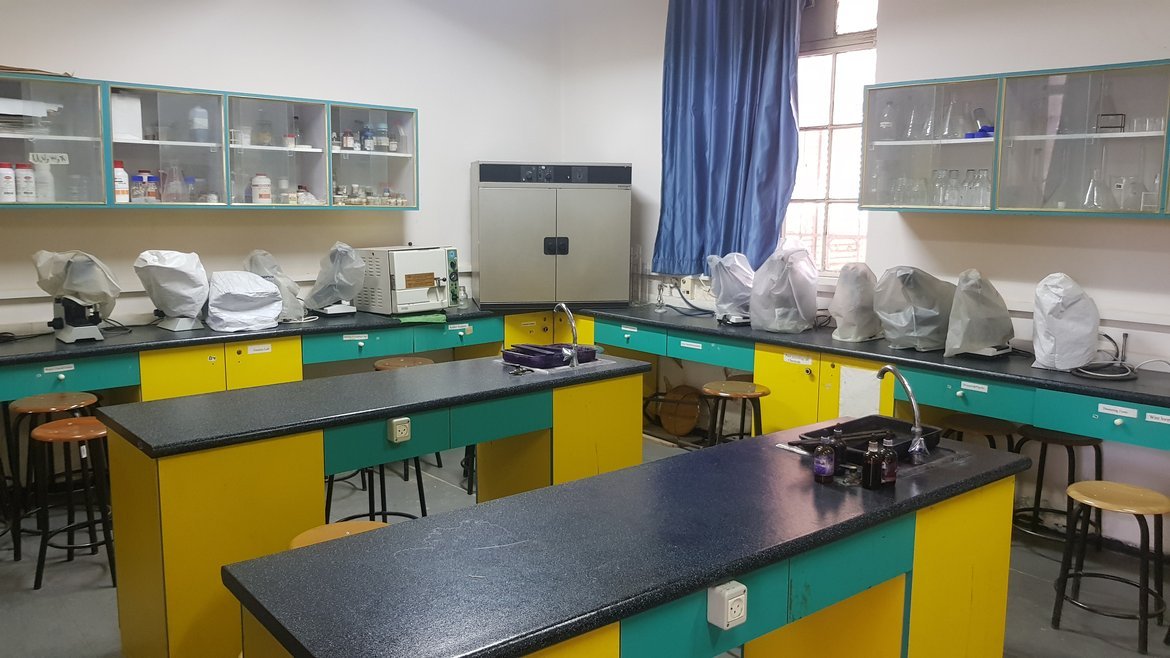
The Virology & Immunology Research Laboratory focuses on virus isolation, serological tests, and immunological studies. It provides a high-tech environment for students to conduct experiments in virology, immunology, and related fields. It is also used for practical exercises in various courses.
Instruments Used:
- ELISA Plate Reader & Washer: For detecting antibodies, antigens, and proteins in viral diagnostics.
- Laminar Flow (Delta Purifier 120cm): Maintains a sterile environment for virus and sample handling.
- PCR (Polymerase Chain Reaction): Amplifies viral DNA/RNA for detection and genetic studies.
- Inverted Microscope (Hund): For observing live cells and viral infections.
- IDEXX Snap Shot DSR: For serological tests to detect viral antigens and antibodies.
- Semi-Dry Electroblotting System: Transfers proteins for analysis in immunoblotting.
- Power Supply 150V-200mA: Powers electrophoresis equipment for protein separation.
- Vertical Protein Electrophoresis Mini System: Separates proteins for viral and immune response studies.
The lab supports research in molecular biology, medical diagnostics, biotechnology, and immunology, contributing to the development of new diagnostic tools, vaccines, and therapies for viral infections. It also aids in public health, medical research, and biotechnology innovations.
The Feed Analysis & Milk Hygiene Research Laboratory focuses on testing the nutritional content of feed and food samples (protein, fat, fiber, calories) and evaluating milk hygiene through physical, chemical, and microbiological tests. The lab is also equipped for soil and irrigation tests, supporting agricultural studies.
Instruments Used:
- Flame Photometer 410, Sherwood: Measures metal ion concentrations.
- Ankom 200 Fiber Analyzer A200: Analyzes fiber content in feed/food.
- Ankom Extractor, XT 10 I: Extracts fat from samples.
- Kjeldahl System: Measures protein content.
- Calorimeter C 200: Measures caloric content.
- Conductivity Meter: Assesses conductivity of milk/feed samples.
- Daisy II Incubator: Incubates samples for fiber analysis.
- Lactometers & Hydrometers: Measures milk density and quality.
- IKA C 200 Oxygen Bomb Calorimeter: Measures energy content.
- Dissolved Oxygen Meter: Measures oxygen levels in liquids.
The lab supports research in nutrition, agriculture, food science, and environmental studies. It improves animal feed quality, ensures food safety, and promotes sustainable agricultural practices, linking agriculture and health research.
The Plant Tissue Culture Research Laboratory provides practical training for students on the processes of plant tissue culture for propagation. Students learn how to prepare plant media, cultivate nodes and buds under controlled conditions, and eventually grow them into seedlings. The lab ensures proper temperature, humidity, and lighting to support plant growth and propagation.
Instruments Used:
-
Incubator/Versatile Environment Test Chamber: Maintains controlled temperature, humidity, and light conditions for optimal plant growth.
-
Laminar Flow, Horizontal (KBM4): Provides a sterile environment for culturing plant tissues, preventing contamination during propagation.
-
Autoclave Tuttnauer Model 2540: Sterilizes plant media and tools by using high-pressure steam.
-
Fluorescent Microscope, Nikon-501: Used to observe plant tissues at a microscopic level, ensuring proper growth and development.
-
Dispenser System: Used for accurately dispensing nutrients and growth regulators into plant media.
-
Steam Sterilizer Tuttnauer 3870E: Sterilizes media, tools, and equipment to maintain a contamination-free environment.
-
Portable Leaf Area Meter: Measures leaf area, an important parameter for assessing plant health and growth.
The Plant Tissue Culture Research Laboratory supports research in agriculture, biotechnology, and plant biology. By providing a controlled environment for plant propagation, it contributes to studies on plant breeding, genetic engineering, and sustainable agriculture practices. The lab helps advance techniques in crop improvement, conservation, and the production of high-quality seedlings, linking plant science with agricultural innovation.
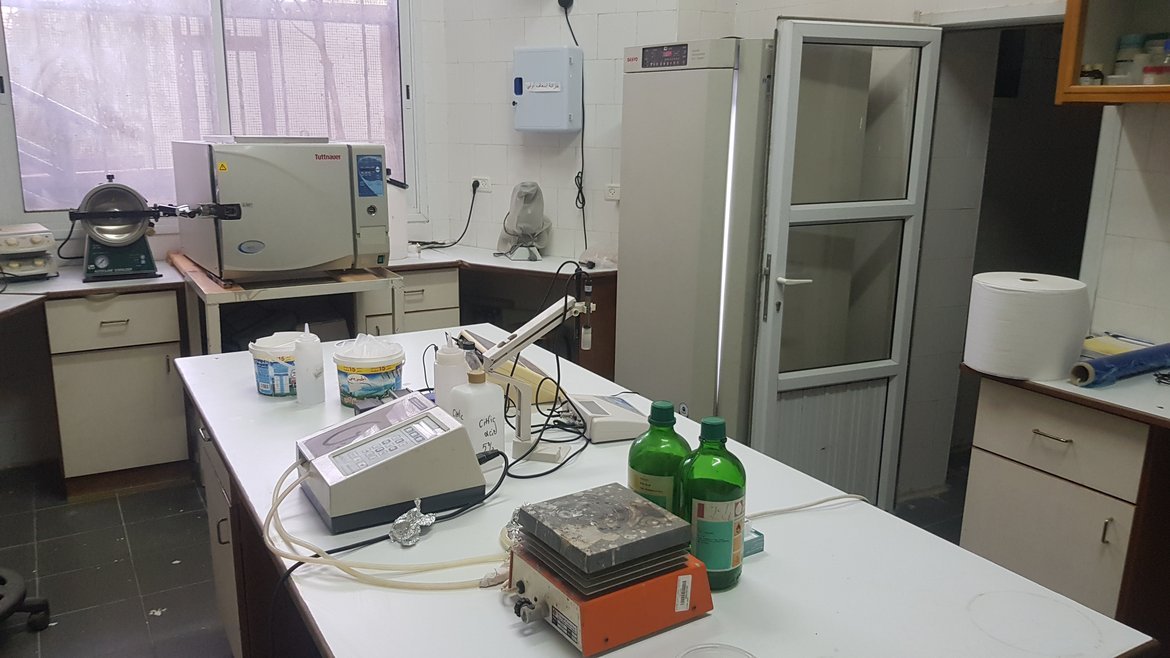
The Plants Incubation Research Laboratory is designed to educate and train students on plant improvement techniques through pollination (crossing) of seedlings. The lab provides controlled conditions for temperature, humidity, and lighting to support successful pollination. Following successful pollination, seedlings are transferred to the field for cultivation and seed harvesting. The lab also supports agricultural research for postgraduate students on topics such as heavy elements, drought, and salinity.
Instruments Used:
-
Air-condition: Regulates temperature to maintain optimal growth conditions for seedlings.
-
Humidifier: Controls humidity levels to promote healthy plant growth.
-
Light Controlling System: Adjusts light intensity to ensure proper light conditions for plant development and pollination.
The Plants Incubation Research Laboratory supports research in agriculture, plant biology, and environmental science. By enabling controlled pollination and plant growth, it contributes to studies on plant breeding, stress resistance (e.g., drought, salinity), and environmental adaptation. The lab links plant science with agricultural sustainability and crop improvement.


